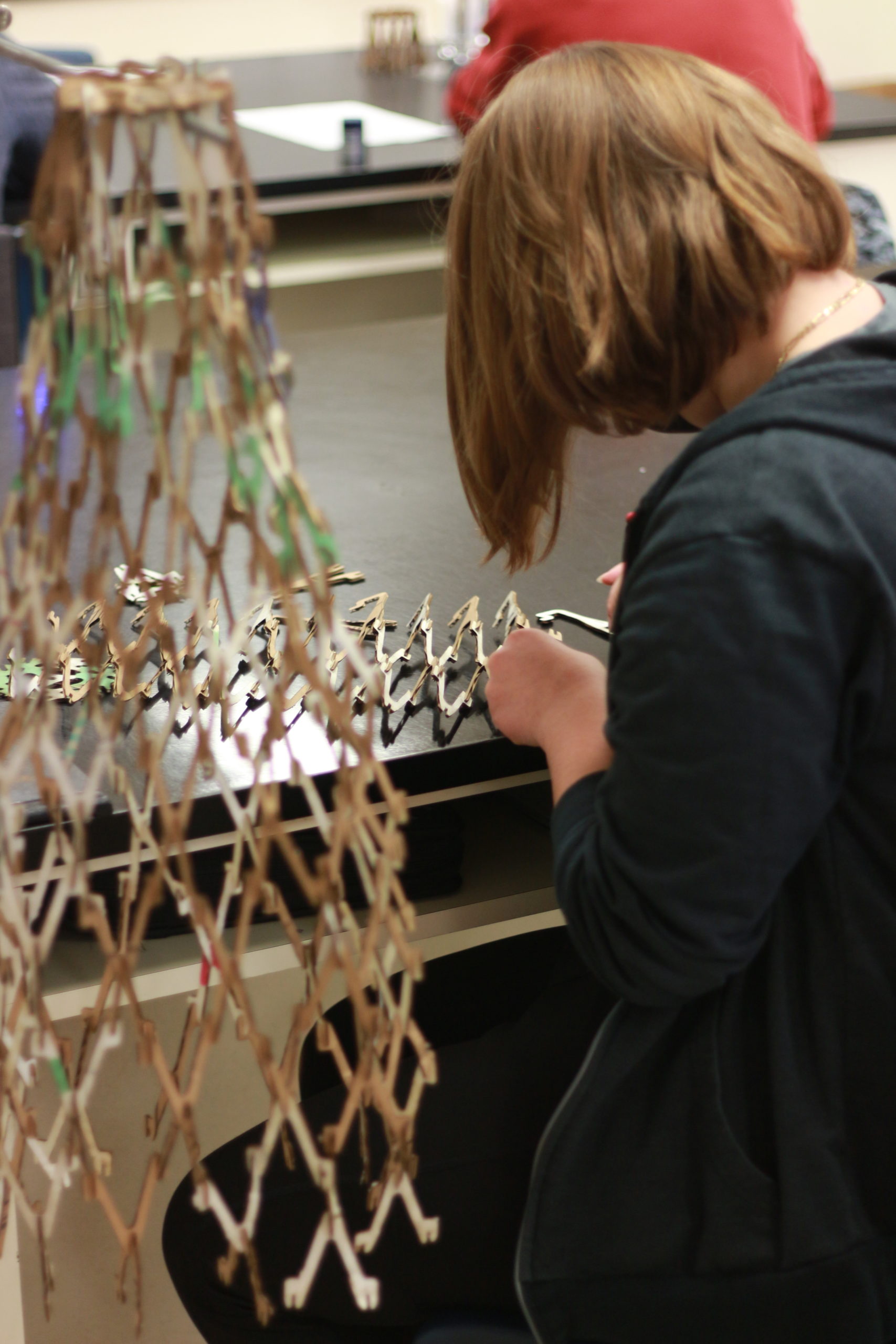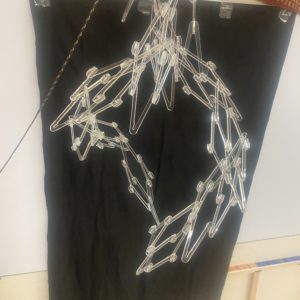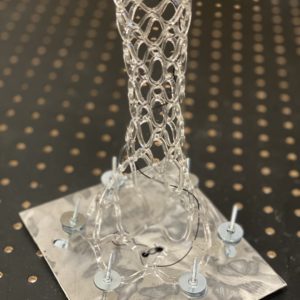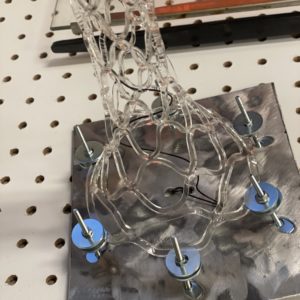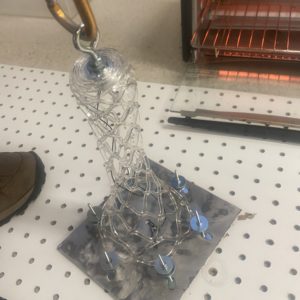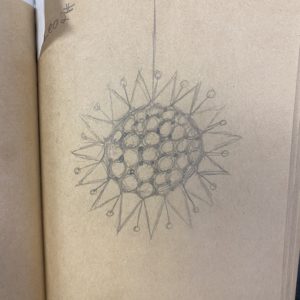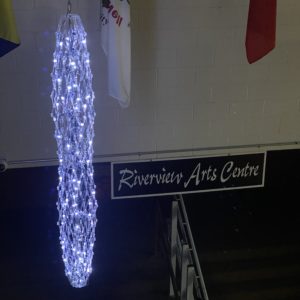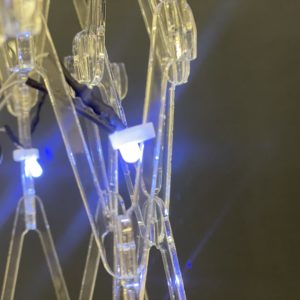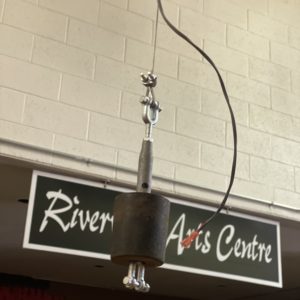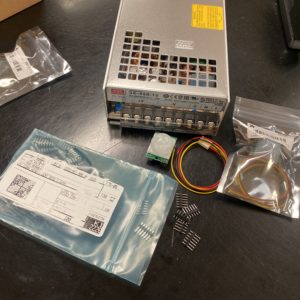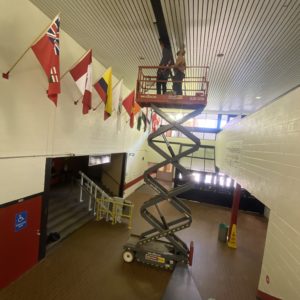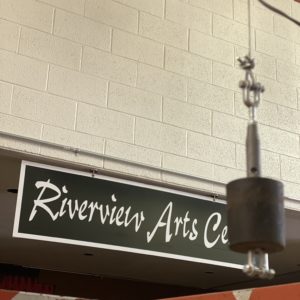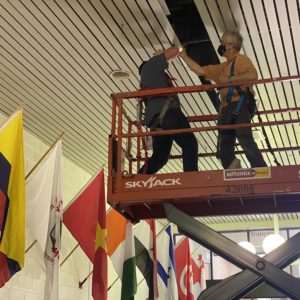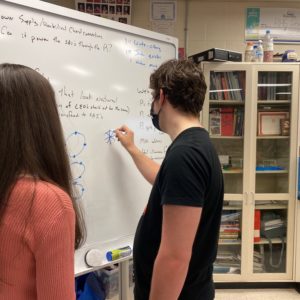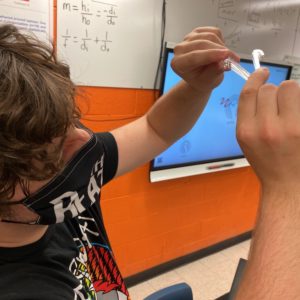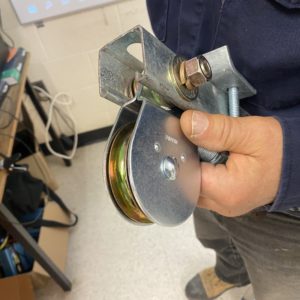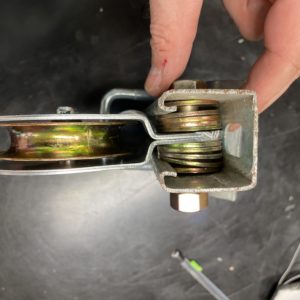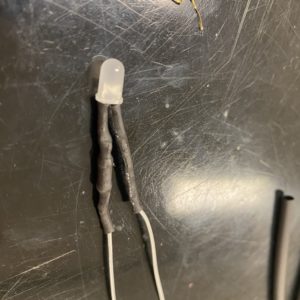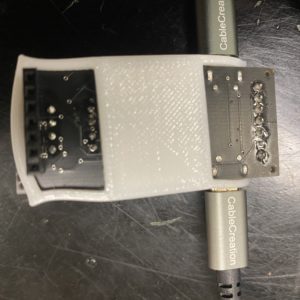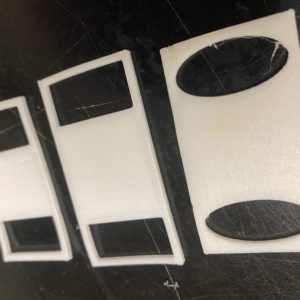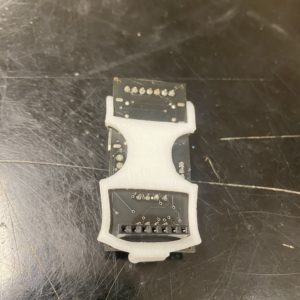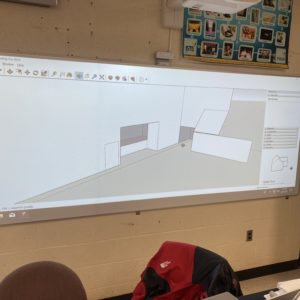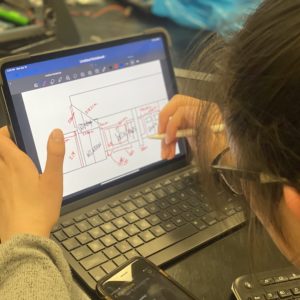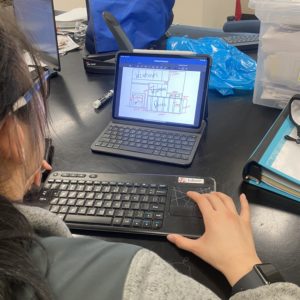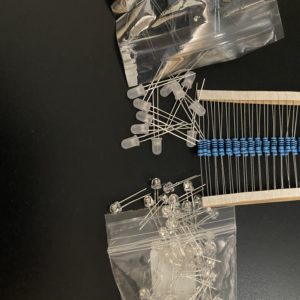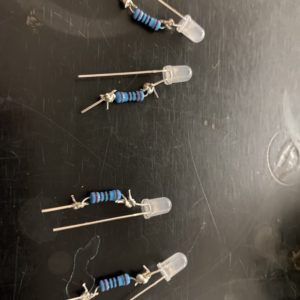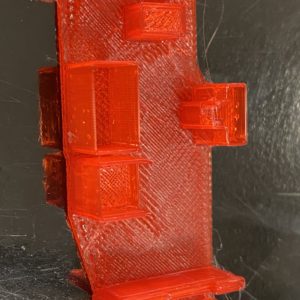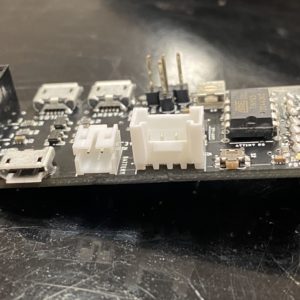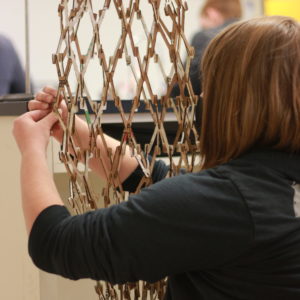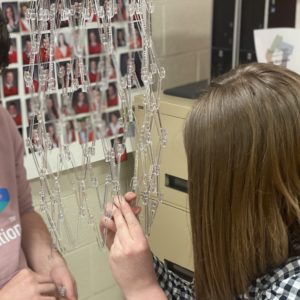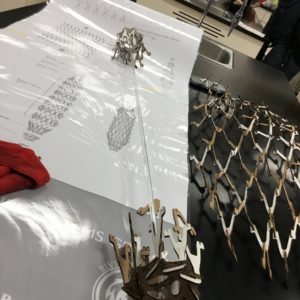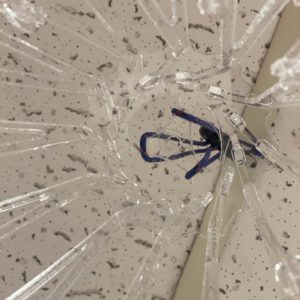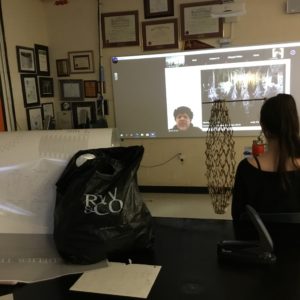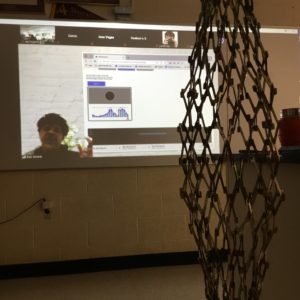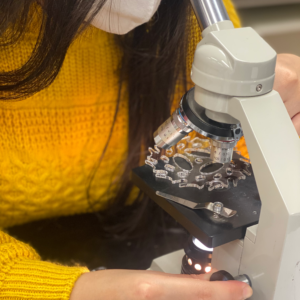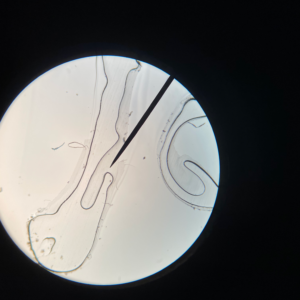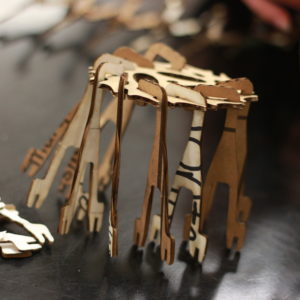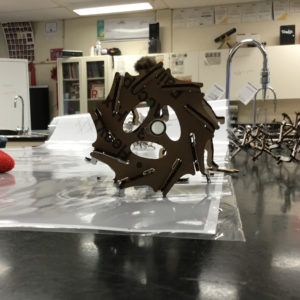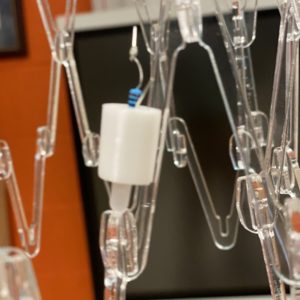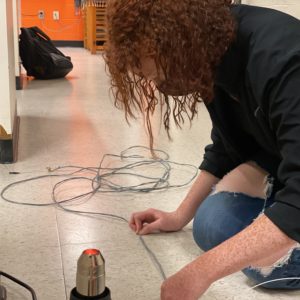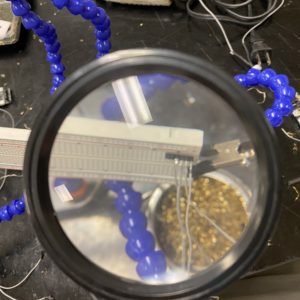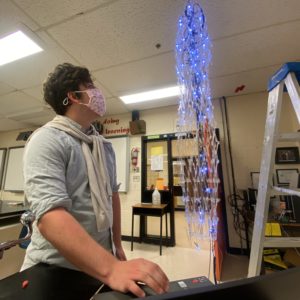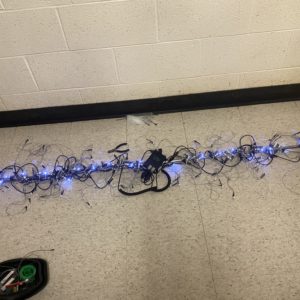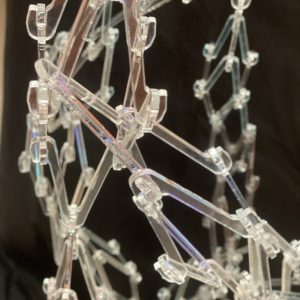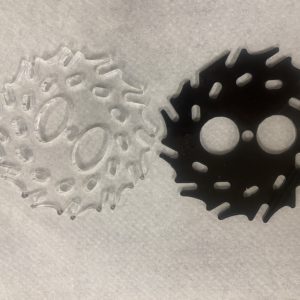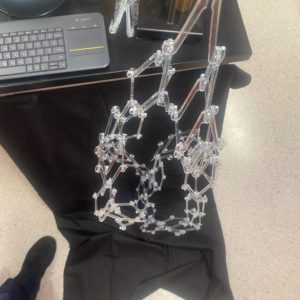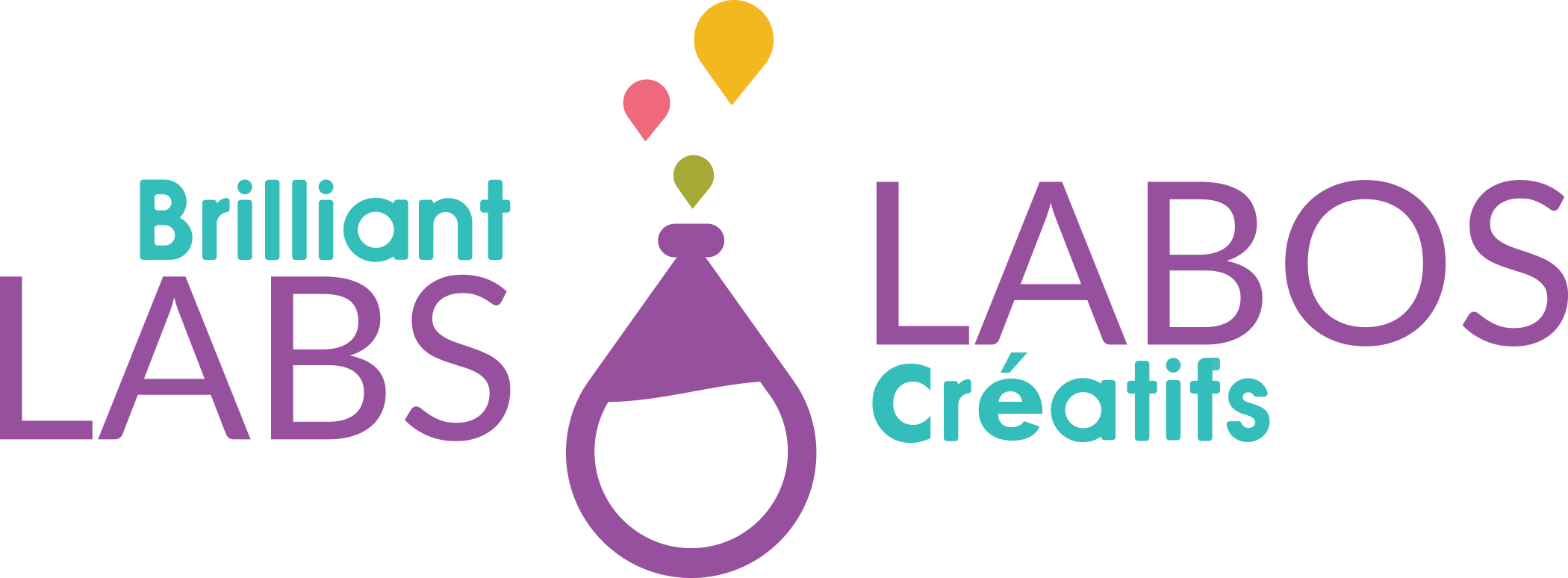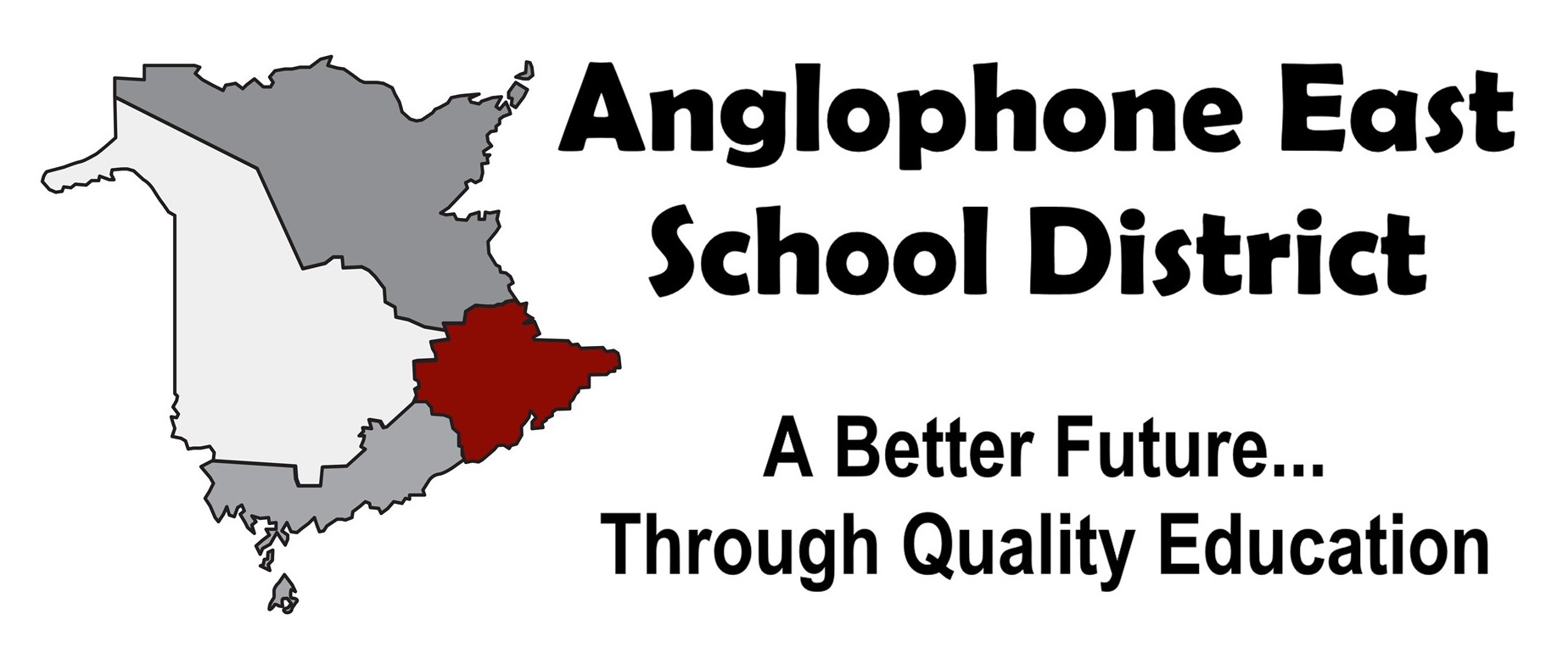LEO Riverview
Riverview High School
Riverview, CAN 2020
High school students at Riverview High School (Riverview, New Brunswick) led by Ian Fogarty have been working with LASG members Rob Gorbet, Matt Gorbet and Philip Beesley since 2020 to combine fabrication, physics, geometry, and STEAM to create embodied knowledge related to science disciplines. The initial explorations of the students have resulted in the installation of a permanent testbed column sculpture in the lobby of the school with ongoing experimental work continuing within the classroom. The installation emerged from a series of digitally fabricated, interactive prototypes supporting active electronics and microprocessors controlling vibrating mechanisms and lights, with possible applications within new kinds of smart buildings and furniture. Custom software configured by the students is being used to control the responsive behaviours within the column.
This cross-country Tech-Art collaboration challenges both students and a school system to rethink the labels they put on themselves, as they explore the transdisciplinary connections between art, coding, psychology, sociology, and electronics. Can students build a professional-quality art installation that will reside outside the RHS theatre, able to respond to stimulus from observers? Can this art installation draw people from different social groups together and encourage discussions about art and education? Can this art installation serve as an example of transformed, integrative education that helps open doors for high-school level students to directly explore and learn about complex innovative technology?
Learning Through Design by Ian Fogarty
Progress Logs — Ian Fogarty
March 3, 2022
It is Thursday night before spring break at 6pm. We ordered pizza and kids are working on a bunch of projects. Some are making protected LEDs, others SAIs, and Abby is playing with chevrons. She has discovered how increasing the kinetic energy of molecules leads to pliability. She is making chevrons reminiscent of Dali’s time poster “Persistence of Memory”.
March 1, 2022
Way back three years ago when I visited the LASG studio, I fell in love with many of the shapes, but I was intrigued by the Eiffel Tower/black hole/cellular pore looking thing that is known as a Spar.
Tonight, we finally pulled our own! We had troubles getting someone to laser cut things for us, so we got our own laser cutter and the bulb blew, alpha happened with the interface, SAIs, pi’s that became alpha. The whole time, the very first shape has been kicking around the class with students wondering what it was, like an ink blot.
This year, we struggled with scale, how to get the .pdf to Sketch Up to a .dxf file, to Inkscape for the .svg to the GlowForge. The scale of our spar meant that the bolt holes were only 3mm. It took me three Canadian Tires and four Home Hardwares to get the nuts and bolts to fit. It took two weeks to order them through the trucker COVID occupation. We had to hand drill a larger hole for the eye hook.
The custodians who seem to enjoy alpha note than anyone doing their work at night time, donated their toaster oven. A math student spent a couple hours in his cold garage sanding the paint off an old and out of date Trans Canada trail sign to make our base.
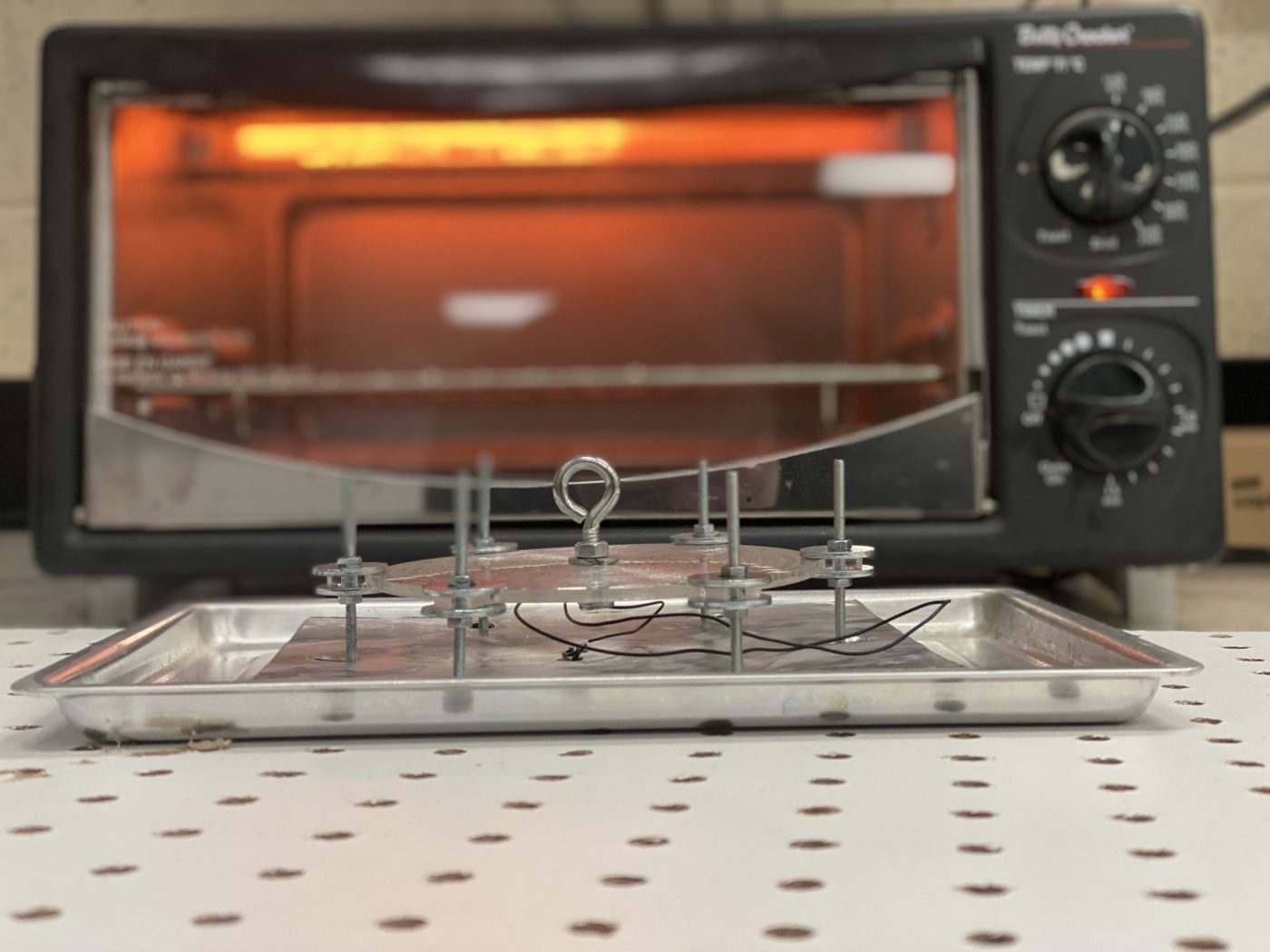
We did not get to the end of our wire meant to help us get a consistent length. A smaller scale might be a good thing for our space.
I was a little disappointed in that the inner cuts did not pull. I expected that the eyehook washer would leave a small flat radius in the center , but the actual was much wider. I feel like I took it out too soon, that the edges became molten before the center and because of the weight started to collapse.
The end result is pretty great and satisfying. Careful inspection shows that it is a little lop sided and it droops a bit. I hope that will be largely not noticeable. But I worry.
Feburary 25, 2022
A new group of students learning to solder protection resistors to LED s over a lunch hour.
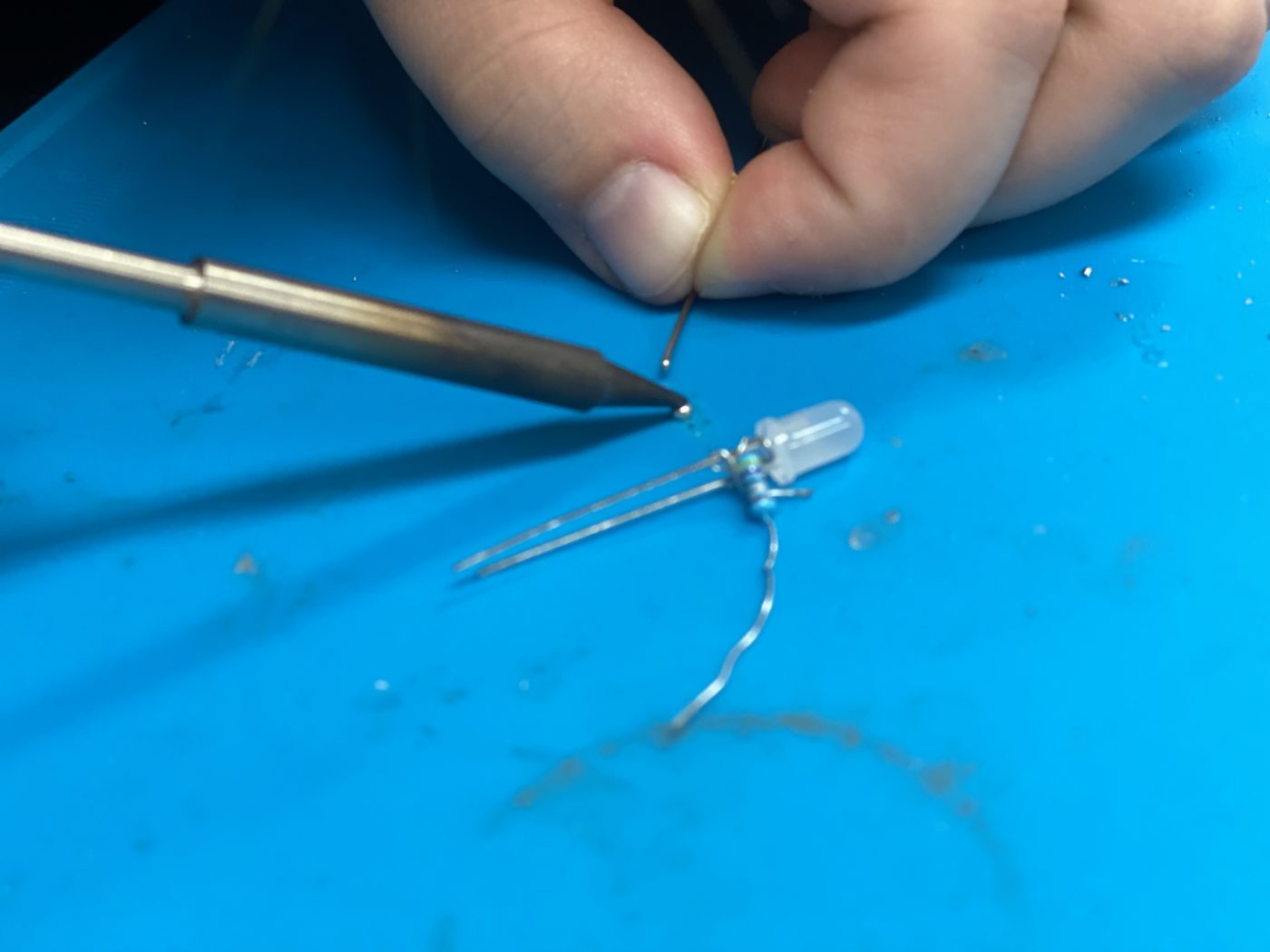
Feburary 24, 2022
We strung up some clear chevrons and some frosted chevrons with some warm white Frosted LEDs. We are hoping to see if there are differences? The video might be blown out exposure. Or perhaps there is little difference. Since the LED is itself frosted, perhaps it has little effect. When I go frame by frame, the frosted (right) looks to be more illuminated for longer than the clear (left).
Feburary 17, 2022
After seeing some of the frosted acrylic (100 grit orbital sander) , they wondered what it might look like in Leo. The flat surfaces were frosted, and we expected the laser cutter to leave mirror edges. Hopefully light would enter the edges and then do lots of cool glowing.
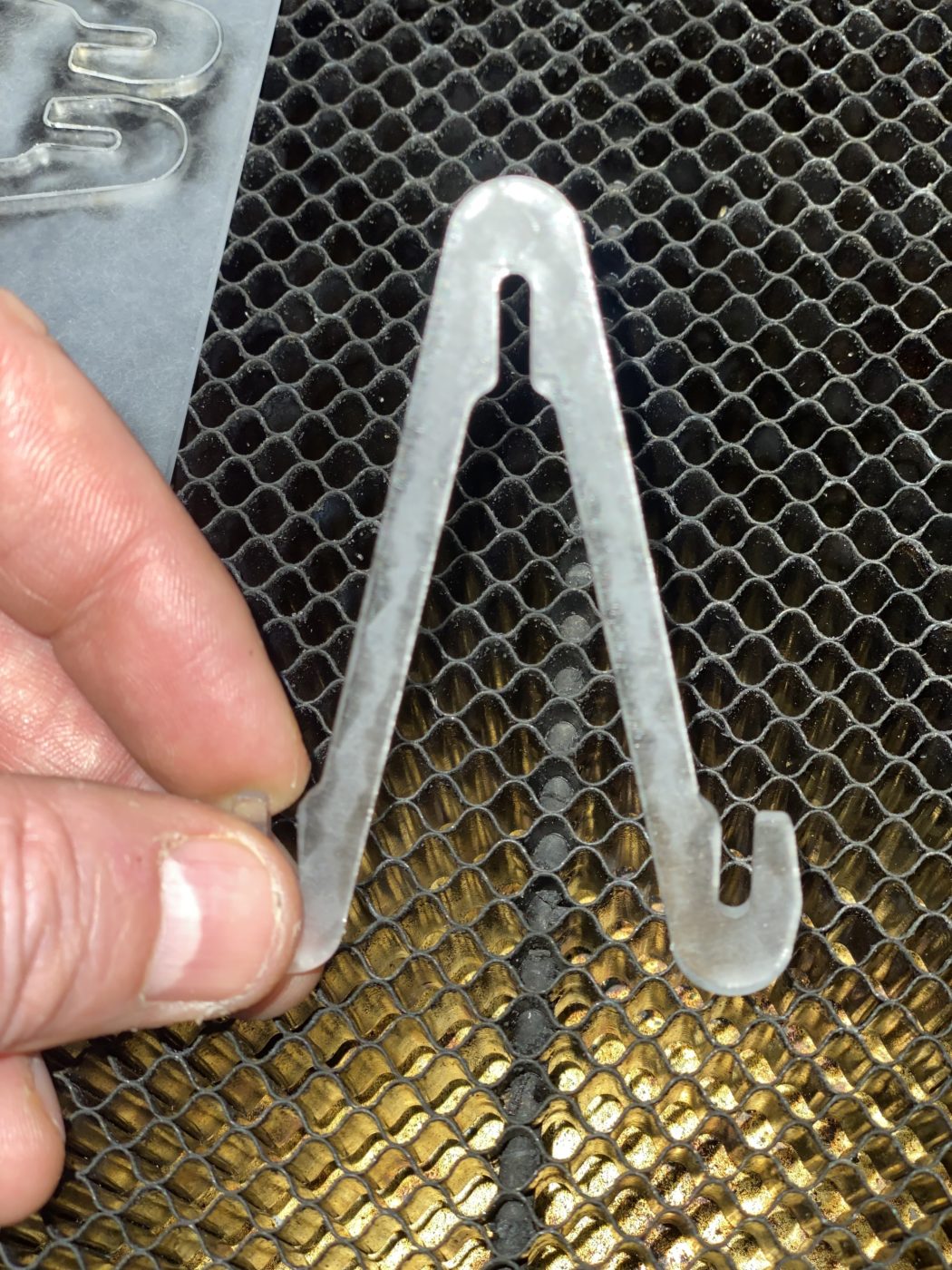
Feburary 12, 2022
Another example of inspiration or contamination. Maddie would drum all last year between classes using the left over chevrons to make the diamond shapes that she dangled in the center of mini columns. These were hanging around the room all last year, so Abbie would have seen them a bunch.
This year Abbie seemed much more involved. Without knowing what was about to happen in just a few hours with the whole group, Abbie starts to tinker. Just playing with shapes, “thinking by doing”. And she comes up with a form that might satisfy many of the likes from the next activity before we do the activity. I want to hide it so that it does not contaminate the next activity. On the other hand I’m loving the individual effort!
She starts with a single chevron dangling from the crook of the V. This will definitely form a weak spot with any kind of weight.
She makes one of Maddie’s diamonds. Then she intertwines more of Maddie’s diamonds. There is a loose connection where one diamonds is torquing on the other.
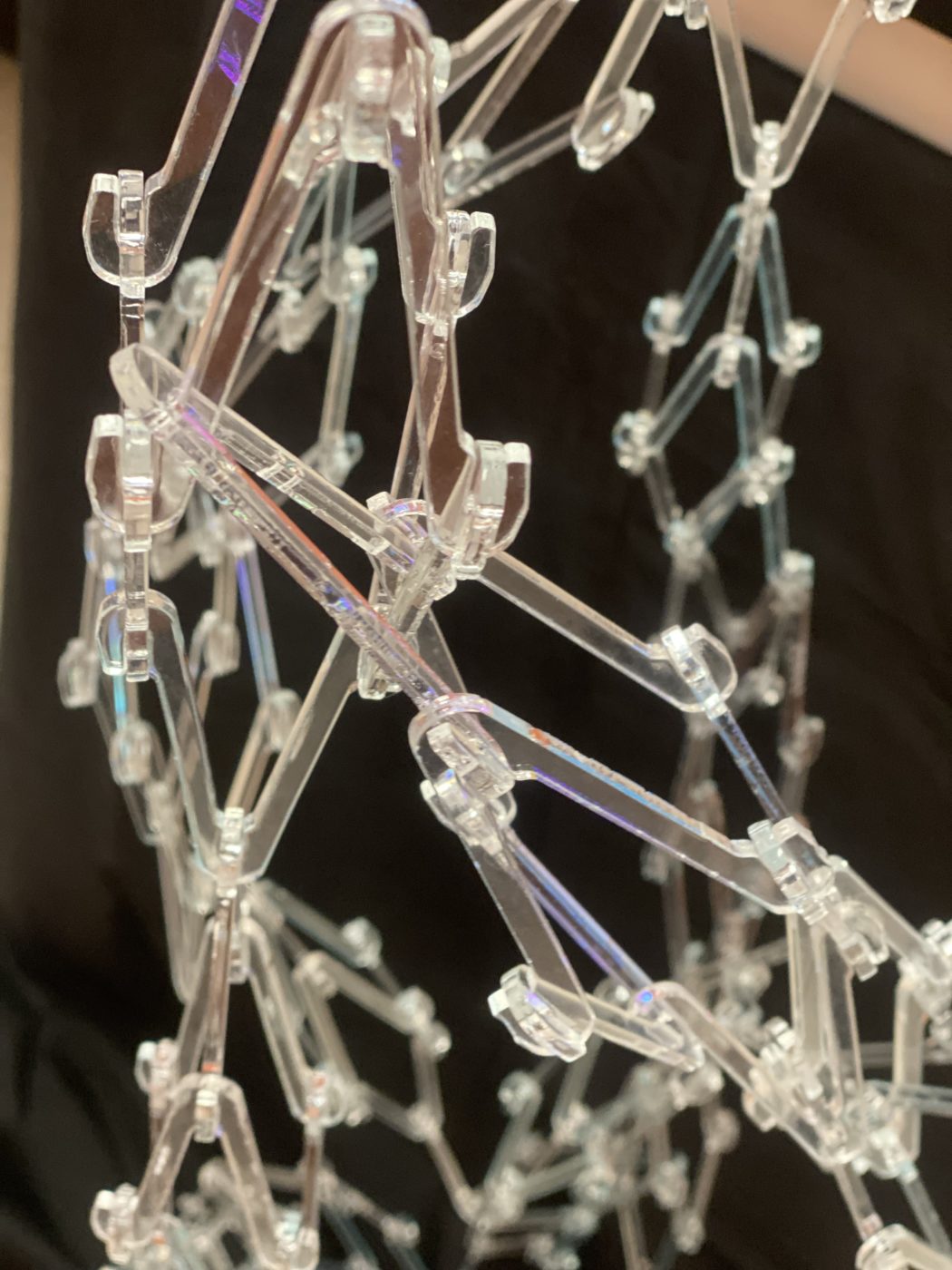
She wants the twist to have less pitch, so she’s thinking about modifying the chevron so there is a lip to catch the subsequent diamond and make a tighter twist.
After school, she disassembled some of it and figured out how to make two twists, then a little lower make two more twists so there are four strands with a vision of making six or eight strands.
She does not know about the electronics, maybe they dangle in the center and the LEDs cables make a spider web to the strands.
We will have some structural issues. We can see the top chevron deforming and twisting. We might want some help to create new chevrons to give us a similar shape.
Since the connections are loose, does that mean there is room for movement? Muscle wire to raise and lower each diamond?
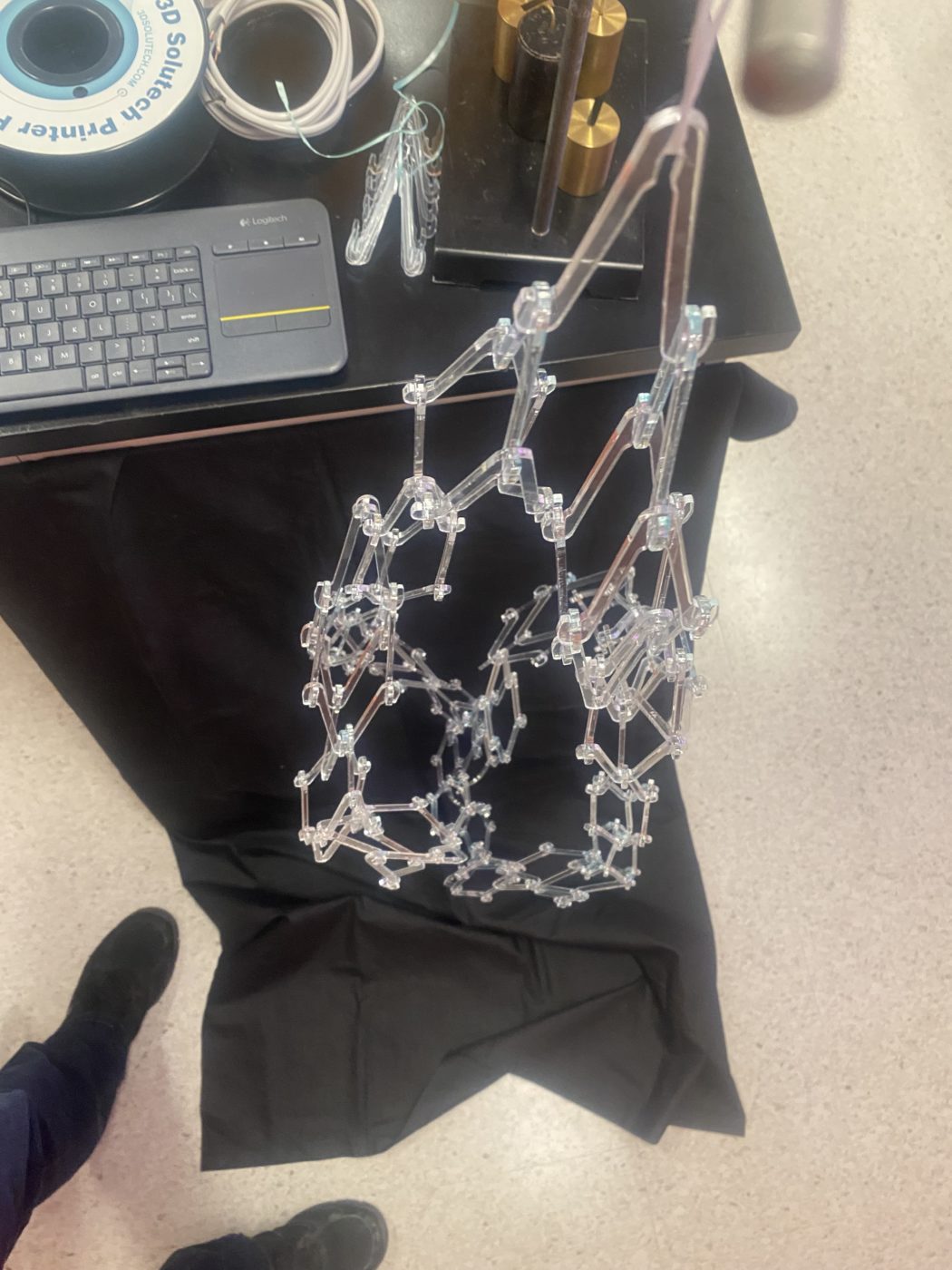
Feburary 3, 2022
It has been a rough semester with all the interruptions of a strike and pandemic. The new semester seems like a fresh start.
The Glowforge laser cutter from Brilliant Labs is up and running after long last. We cut a new end plate out of thick 5mm acrylic.
However, we wonder if the acrylic is causing issues with the sensing in Alpha, so Maddie edited the files to make circular cutouts as a peep hole for the sensors.
We discovered by accident that we had a piece of bronze acrylic. It turns out that we were also given a free piece of frosted and white acrylic. I wonder if we use some of it for the Rpi case or perhaps using frosted white for the end plates ?

September 14, 2021
The start of a new year.
The first thing that Maddie said after hi was, “I did some drawings for the next LEO over the summer. I’m thinking of a sphere”.
She’s in!!!
One of the things she looked at was a redesign of the end plate to accommodate the IR proximity sensors.
June 24, 2021
Alpha Leonis graduated today, at least most of its makers did.
It was cool to see the kids. When I was not on duty, I could interact with some of them. I gave them all a laser cut Alpha Leonis keychain/Christmas ornament/book mark. I did not see everyone. Hopefully some of them will stop by tomorrow.
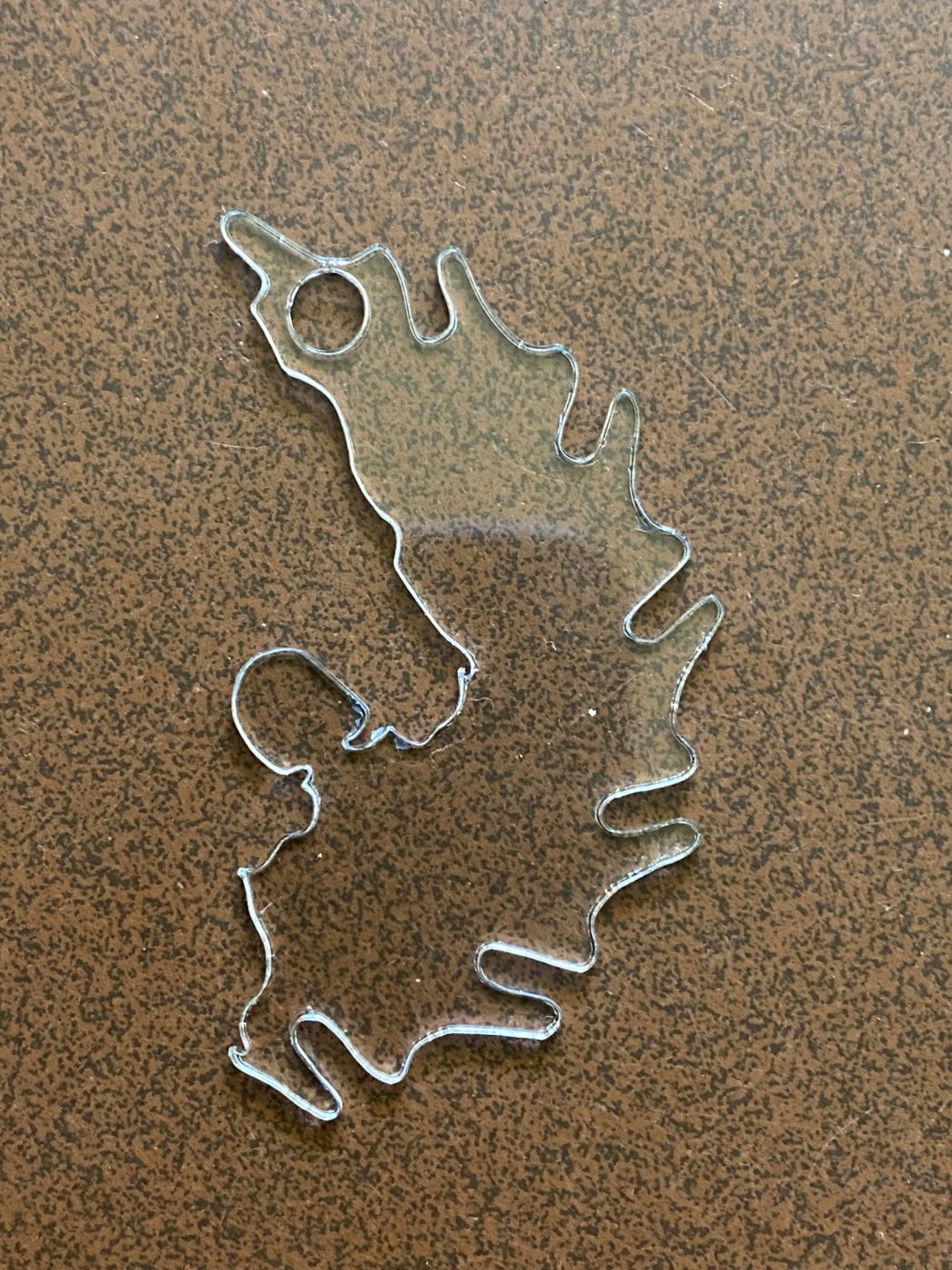
Mia tells me that while she is in vet school, she wants to make… an automated childcare detection blanket for horses.
Back at the beginning of the year, she liked the idea but was too insecure about getting the abilities to code and learn about automation. She wanted to think about what it would do and have someone else figure out the how. She wanted to be the inspiration, not the labor. It appears as though over the year she has learned that she can learn, and that is super empowering. While most were excited to be done or just taking it all in – she has a look in her eye talking about how she is going to do the project and she is not going to wait. A different lesson about the power of people in their 20s to do cool things.
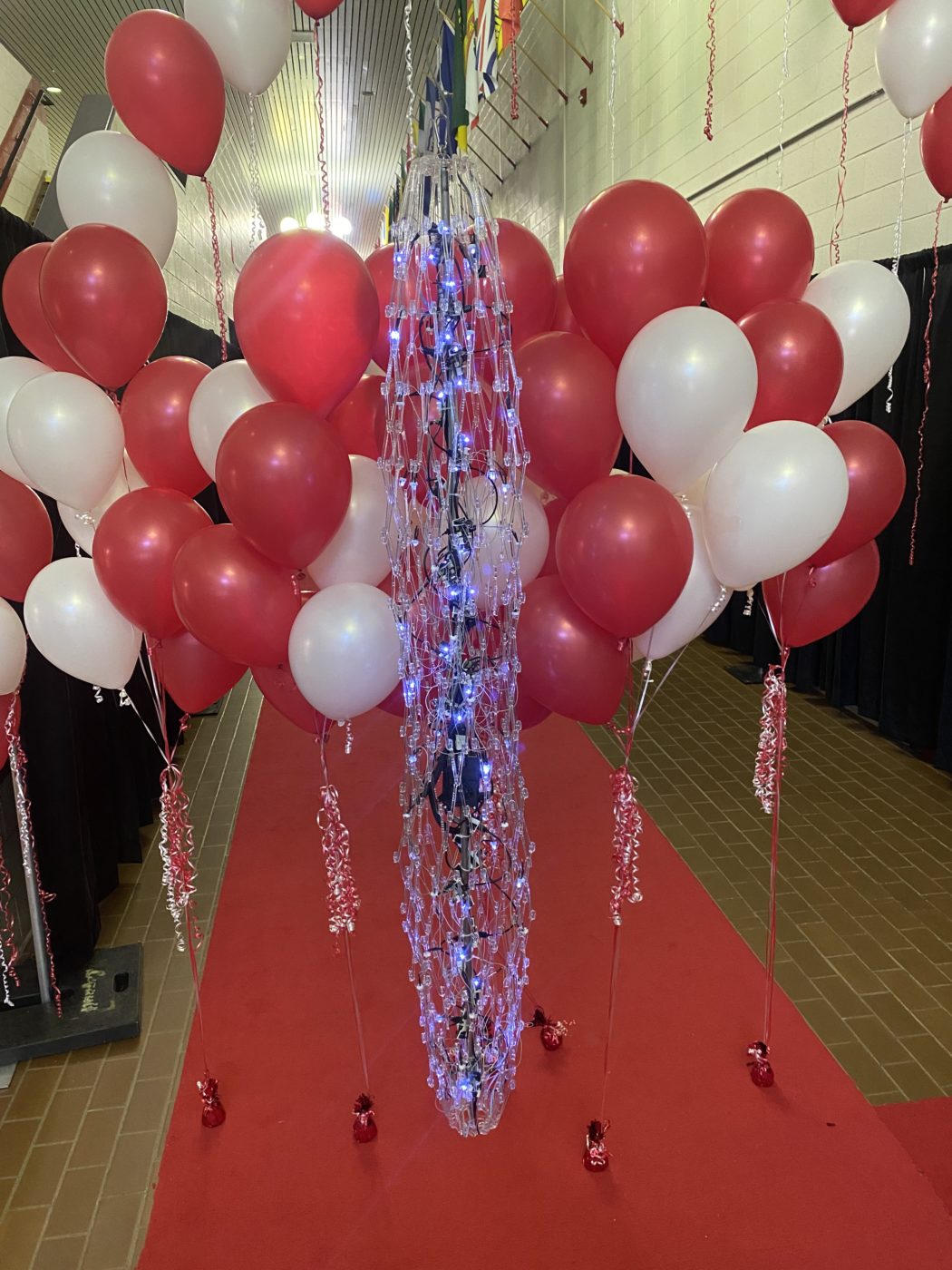
June 18, 2021
We have been trying create a logo for a while. Previous entries showed Joel (Art Teacher) and Maddie talking about deliberately trying to incorporate the question mark symbol to represent the questioning and uncertainty in our Light Embodied Odyssey Project. We have lots of questions about how to do this project, questions about whether we will be able to pull it off from a school and infrastructure point of view, questions about whether people will like it and let us continue in coming years, and questions about whether the audience will gather around and interact with it once it is up and running.
He then got her to think specifically about NOT using the question mark and what might that look like?
Other contributions are around our Mascot the lion, LEO the constellation and of course there is the structure itself. After lots of brainstorming on Maddie’s part over months, she came up with a few different options.
Here is one…
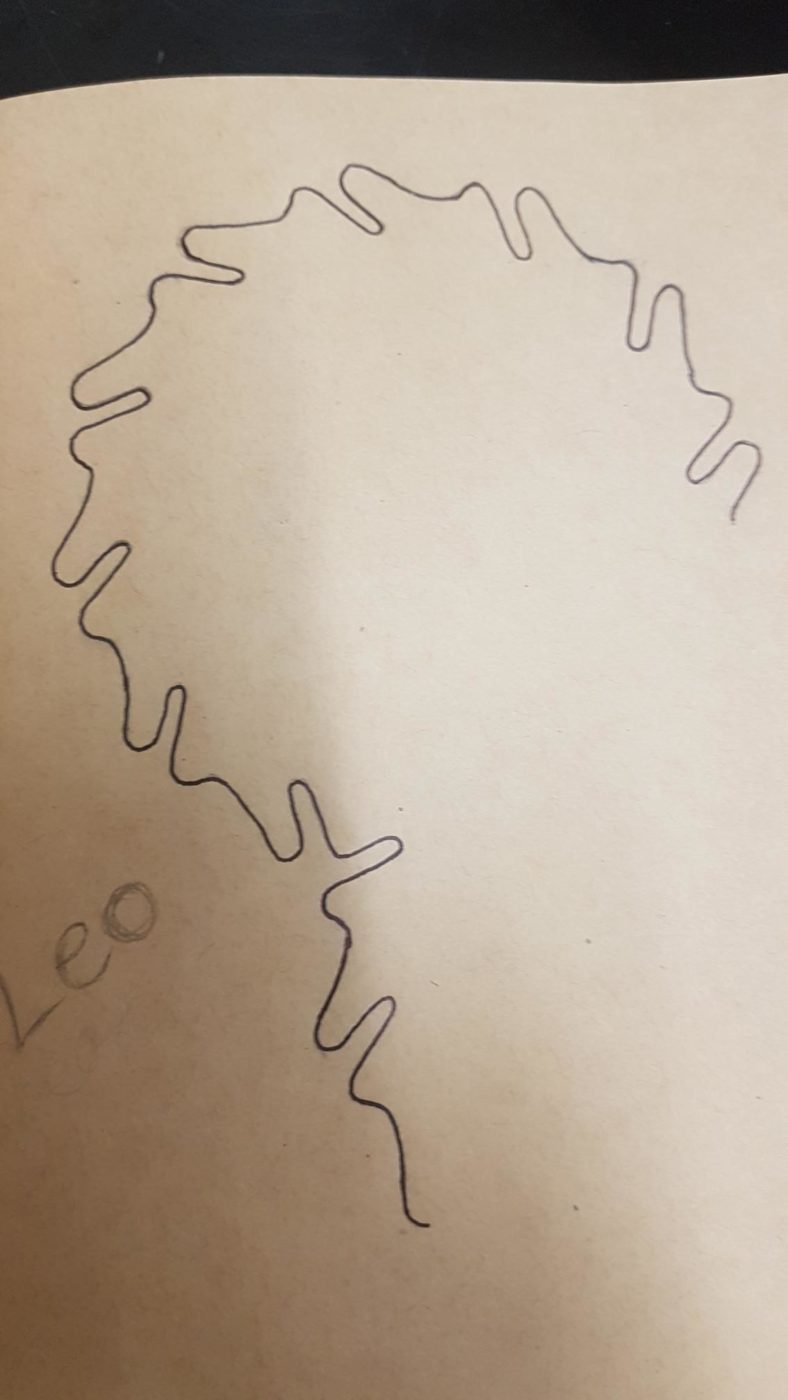
As proof of the power of Diffuse Thinking, Maddie was going about her normal business over the long weekend and had an “all of a sudden idea”… an idea that took months of back and forth and suddenly appeared. Without the time on task, the “all of a sudden” would never happen. It is a bit like when a rock band says that “they were an instant success”, but ignore the decades of playing in bars along the way. She came to school and traced the edge of the endplate to form the mane of the lion and the question mark.
It took guts to put your idea forward to your friends. The rest of the group started to make comments about their reaction. One comment was that it was too thin. The weight of the ink needed to be larger. Another comment was about the empty space in the question mark. A third comment was about not knowing what it means. It was far enough away from the constellation that viewers would not make the connection. There is nothing to link it to RHS. The question mark was not obvious. A short conversation about: does it need to be obvious? Is it a bit of “secret society” to know the layers of the logo? Could we make it a scavenger hunt for people to discover?
Yet again, creativity happens when by-standers who were there by happenstance to all of a sudden make a contribution. It happened previously when Mia flippantly mentioned the idea of facial recognition which initiated his journey to AI, a Pi with a camera, a full time COOP course, a pitch to Sustainapallooza (local Dragon’s Den) and a decision about post-secondary studies.
Maddie retraced her logo with a more weighted digital pen.
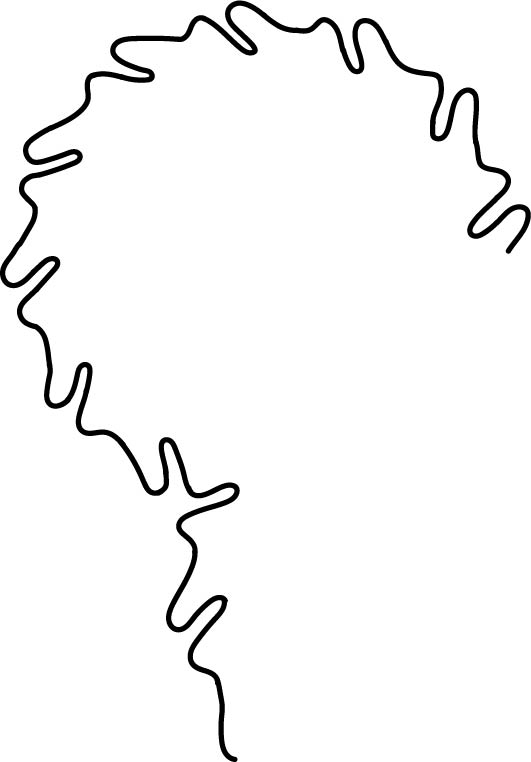
This time it happened with Myah, who is responsible for the Sketchup of the Atrium. The students were having conversations about Maddie’s latest idea and Mia grabs the endplate and starts to imagine what might happen if the lions face was included somehow. Rob suggested using the holes in the endplate to help create a face. Myah then walks across the room with her iPad, and starts to sketch, take pictures and and then edit the pics. After about twenty minutes, she had something to present.
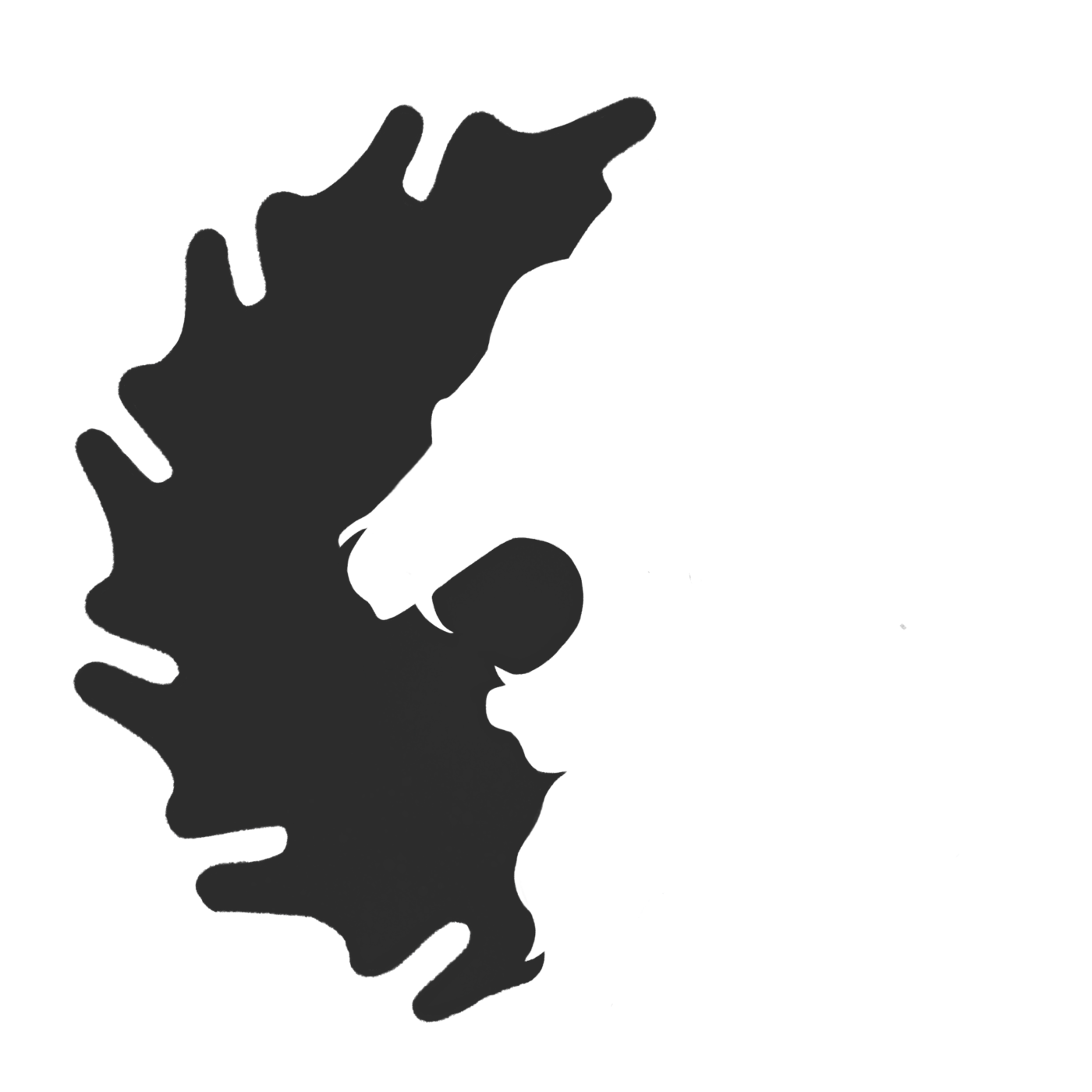
If Maddie had not been thinking, if Joel had not interacted, if Maddie had not been brave enough to post her idea, if Mia had not voiced some of her ideas in an open and constructive way, if Rob had not mentioned the holes and face idea, if Myah had not made a habit of having lunch in my room, if this had happened on the opposite track day (COVID protocols), Myah would not have been there, none of this would have happened. As it turns out, if Rob and I had not gone out for a bit to eat after a Shad meeting, and we had not asked questions to each other, this would never have happened.
Inspiration seems to come from lots of contributions and experiences. I wonder if we provide enough disparity of experiences to students? I wonder if transdisciplinary projects are a way to practice making connections between disciplines and will we create more creative people who can make viable solutions for problems of today and tomorrow? Going to museums, traveling, meeting different people, eating lunch in a particular space are all investments and we never know when or how inspiration will draw on those experiences. Perhaps the foundation of inspiration is so far removed from the event, that we do not recognize the connection and believe it “came out of the blue”. Does this point to how we should create and education, both a formal system and as a lifestyle? Who knew this entry was going to end up in this place?
June 20, 2021
Here are some pics detailing the install.
June 11, 2021
First day of exams, and more importantly, column raising day. This morning the spine and SAIs are on the floor, loosely zipped. There are four more SAIs to be added for a grand total of twenty-four. First thing is to screw the top plate on and suspend it from there.
While students write their first exam, I am going to 3D print a short and long sensor blinder and start working on the software updates to the Pi that Matt and Rob made. There are lots of things they added, most notably the ability to remotely reset the Pi.
Calvin finished his exam and was going to go home, but instead stayed behind to build. He planned on hanging out for only an hour or so. He stayed until 5:30… the magical cut off time. The only way this has a chance to finish today is because of Calvin. He built the column even while his classmates were writing the same exam that he just finished. No one even knew he was there. He was so methodical. Slow is smooth and smooth is fast.
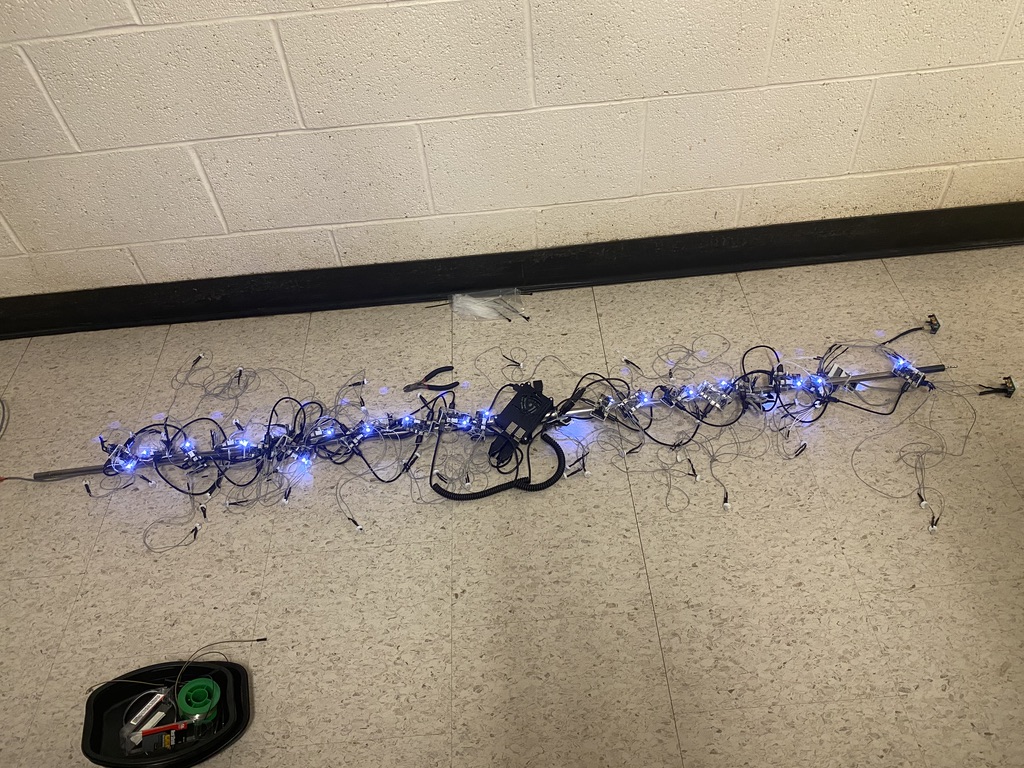
Of course we had to check the sensors. The wires of one sensor have been hot glued to the connection (Don’t tell Rob) because they kept falling off. For the other sensor, I made my own connections with jumper cables and they seemed a more secure fit. The sensors are firing non-stop as expected. We choose High sensitivity and High trigger so that it would continuously fire, which we could mitigate if we desired with software. We installed the sensors to the bottom, with long blinders. Put it in a box to calm it. When we opened it up… the triggers did not work at all. FRUSTRATING! Since it is 5:30 and we all have things to do, it is time to step away. Plus, I really don’t like the look of the sensors on the outside of the column. They look like some kind of mini cow udder. So I cut them loose and just let them dangle for the night. We will see what happens when they have a whole night to “rest”.
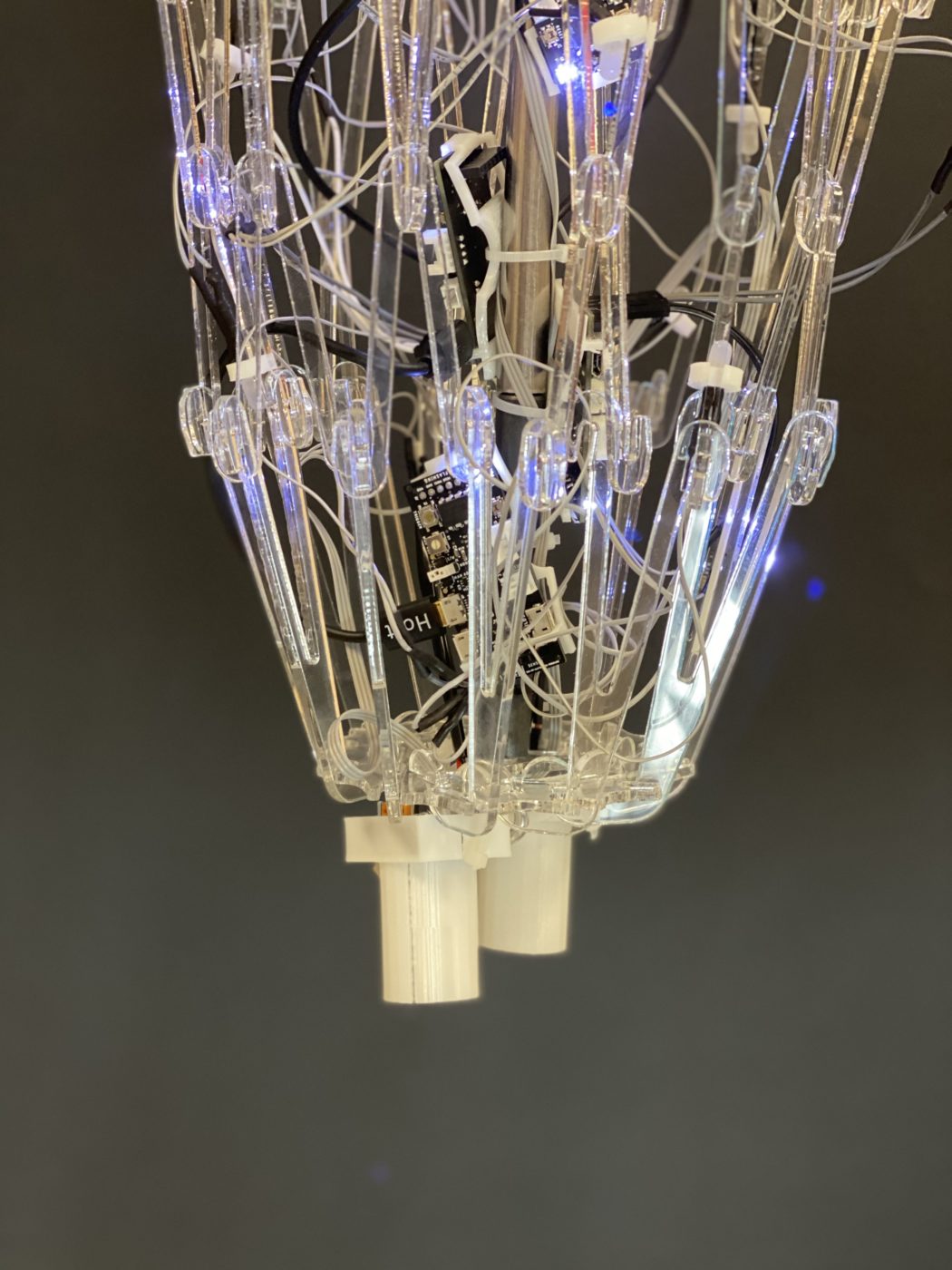
June 4, 2021
Yuval, Winter and Jose spent some time drumming through the details of the trigger. It took much longer than I had hoped, but they finally started experimenting with triggers, lift patterns. They started to realize the tertiary structure of lights. If you want to mimic emotion, we need to consider not just individual LEDs, but the LEDs performing as a group. They add the trigger settings. I made a comment about how the coding could have human implications. Can the trigger conditions create curiosity? Will we configure the trigger so that it fires when the person is underneath it, and then nothing until the person gets bored, decides to leave… and then fires again to entice them back with curiosity?
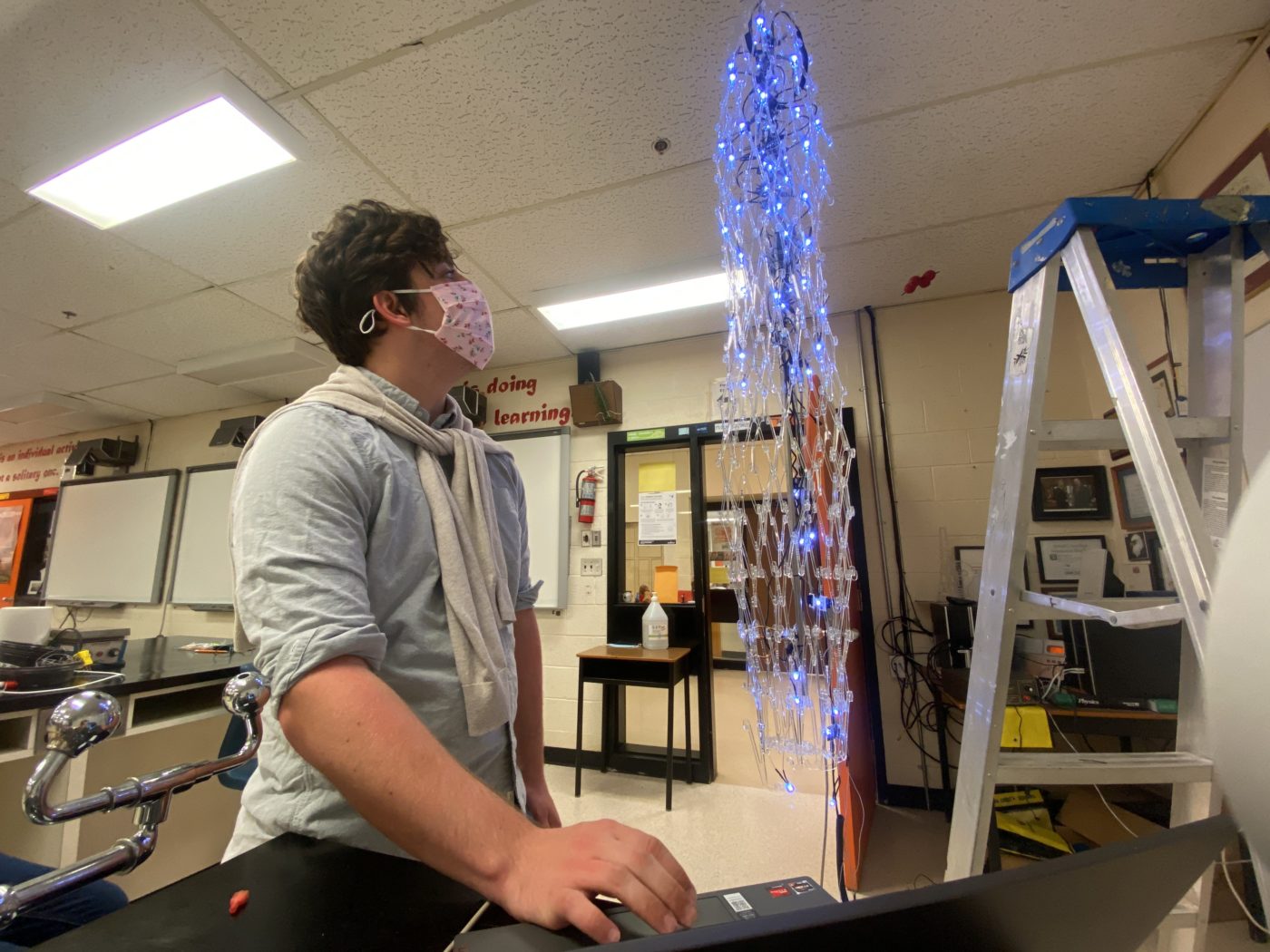
June 2, 2021
Our facilities guys came and took our umbilical chord and installed the deadweight. There is a block to prevent the column from going too far into the conduit. It hangs 6ft below the ceiling. The column is about 6ft, which places the bottom of the column about 12.5 ft from the floor.
Inside the control room the final length is secured to the wall so the bottom of column will be no closer than 24 inches to the floor.
May 28, 2021
Winter has been taking the lead on assembling the structure, the connectivity of the SAIs, and putting them all together. During our work day a little while ago, we discovered that some LEDs were sometimes working and sometimes not. It became so complicated to figure things out, that they disassembled the whole thing.
They laid out all the SAIs on the floor to help ID the problem children and LEDs. We discovered about 6 SAIs where not reliable. We think we have 20 in working order. Some had working onboard LEDs but not working or unreliable external LEDs. Others did not seem to allow the signal to transmit past it.
Trying to undo the hot glue and remove the wires was challenging. Fortunately, our Digikey order included 5 pin, headers.
Trying to solder the LEDs to those headers was a challenge. Rob suggested we place the headers in a bread board and I got out the dreaded MAGNIFYING element.
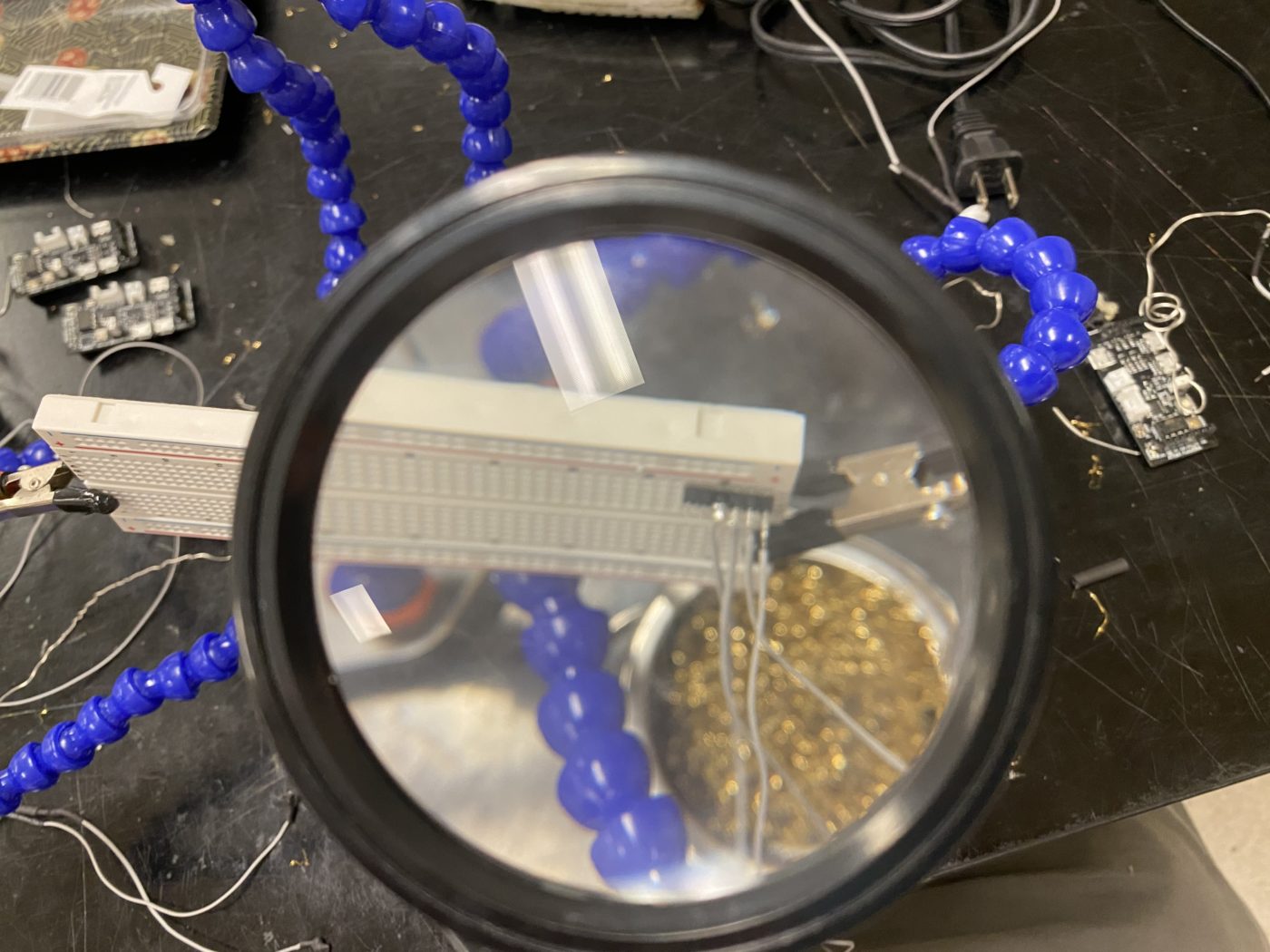
May 27, 2021
Today, we had a few different students as part of the physics class who needed some work to do work on the umbilical chord. We planned on 80ft so that should give us plenty to spare. They cut the cable with a grinder which was fun for them. Then they cut approximately 80 pieces 1” long of the heat shrink. It is a bit opaque white until it shrinks to clear. It should be perfect. They place them 1ft apart using the floor tiles as guides.
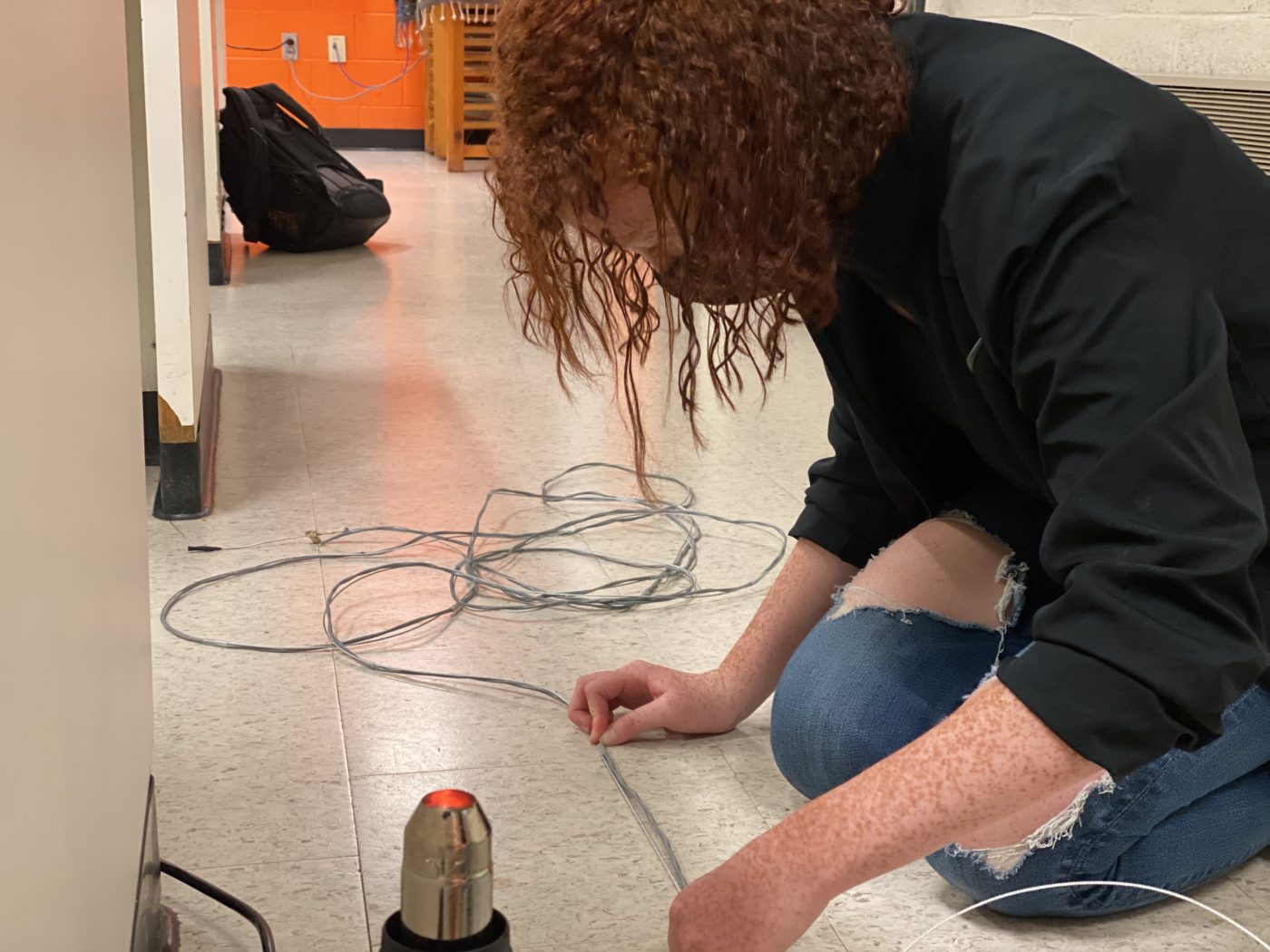
Once that was done, they attached the umbilical chord to be DC power supply and a 12V to 5V transformer and then to a RPi. The power light on the Pi illuminated around 10V. It is closer to being alive.
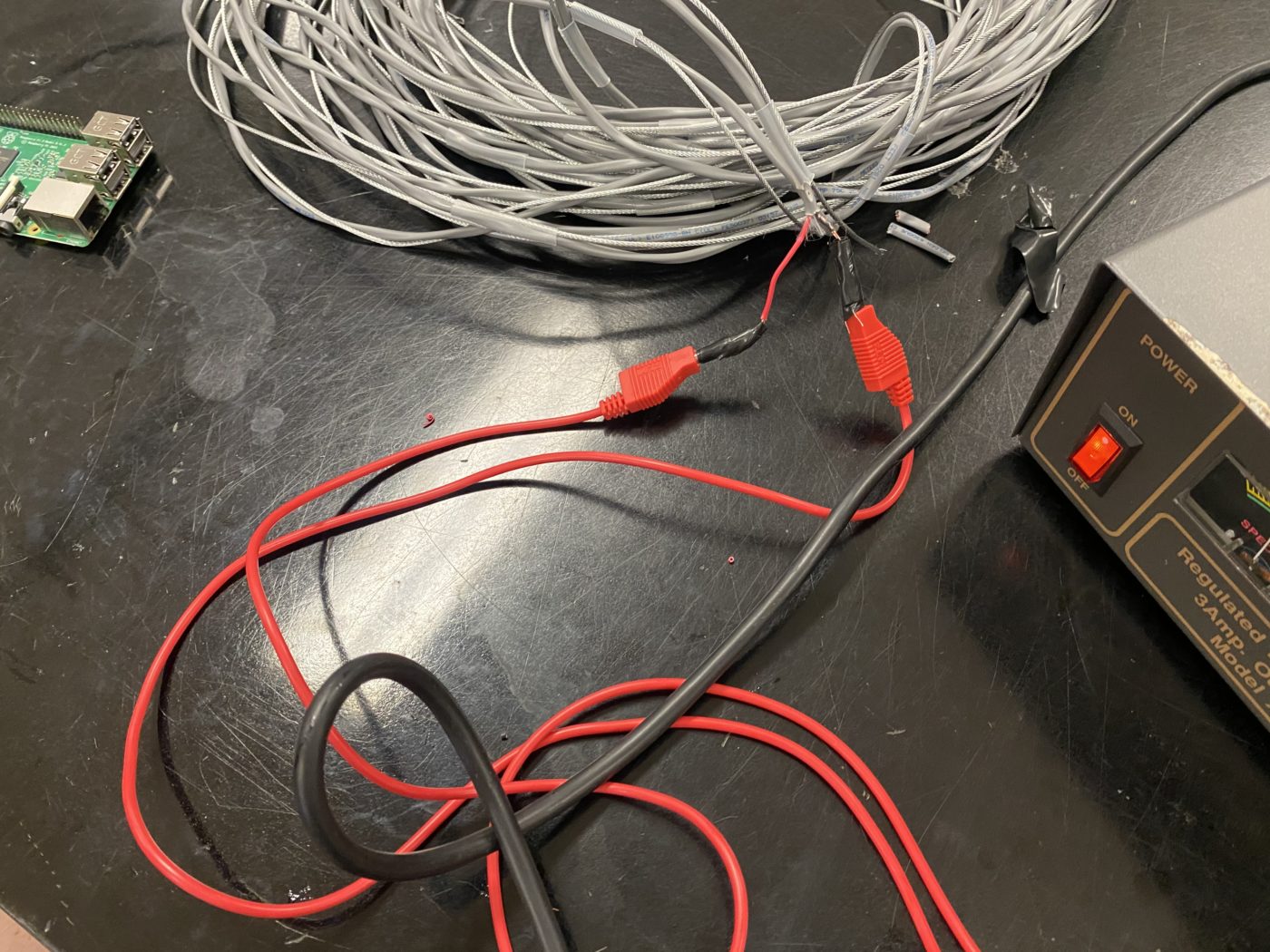
May 22, 2021
Our stainless steel spine was delivered. It still needs a bottom adapter to hold the bottom end plate and sensor, but it gives us a chance to make some physical progress.
Winter has been the one who has been most active in playing “Drumming” with the SAIs, using different branch combinations. I had hoped that students would play some more, but having a group decide on a creative solution is challenging at the best of times, let alone when the students are on intermittent attendance due to COVID restrictions. It is not what I hoped for, but is reasonable given our situation. Perhaps next year.
To reduce the number of chefs in the kitchen, I put Winter in charge of deconstructing and reconstructing the columns, but now with the spine, the SAIs, and the external LEDs.
He and Sarah sorted all of our chevrons so that we can choose the best ones for the final column.
May 21, 2021
Robert and his partner from Facilities brought in the jack, at no cost to us. Today, they drilled a hole through the cinder blocks, sourced the aircraft cable, and the wire. They decided to use a stranded 18 AUG wire with a some kind of special insulation. It will be more stiff than speaker or lamp wire. They also found clear/white-ish heat shrink tubing rather than tape. I am hoping that it will create an umbilical chord that disappears into the installation.
They are rethinking the use of lubricant in the conduit as they believe it will dry out. Sure it would be slippery for the first pull, but eventually will dry and increase friction. Using lubricant would also mean that the people who are raising and lowering the column may end up with a powered on their hands and in the air underneath the column.
They sourced and brought in a model of the pulley system, clamps and conduit.
We talked a little bit about how the chord might come through the ceiling. I wondered about using a lamp fixture to create a larger tunnel that a weight would be able to comfortably transit through the soffits. They suggested a plastic Grommet.
Interestingly, their drill bit was not long enough to go through the hole wall. So they drilled from both sides.. and they met in the middle!! There is no way that I would have been able to do that so accurately!
May 7, 2021 — Rob Gorbet
With a 13′ hanging height, we need to be able to detect at a range of ~9′ if a target might be 4′ high. We have had difficulty with our usual Sharp IR sensors, our go-to for other installations, at that height.
The Sharp GP2Y0A710K0F is a (supposedly) long-range model with 100cm-550cm range, so I got one to test with.
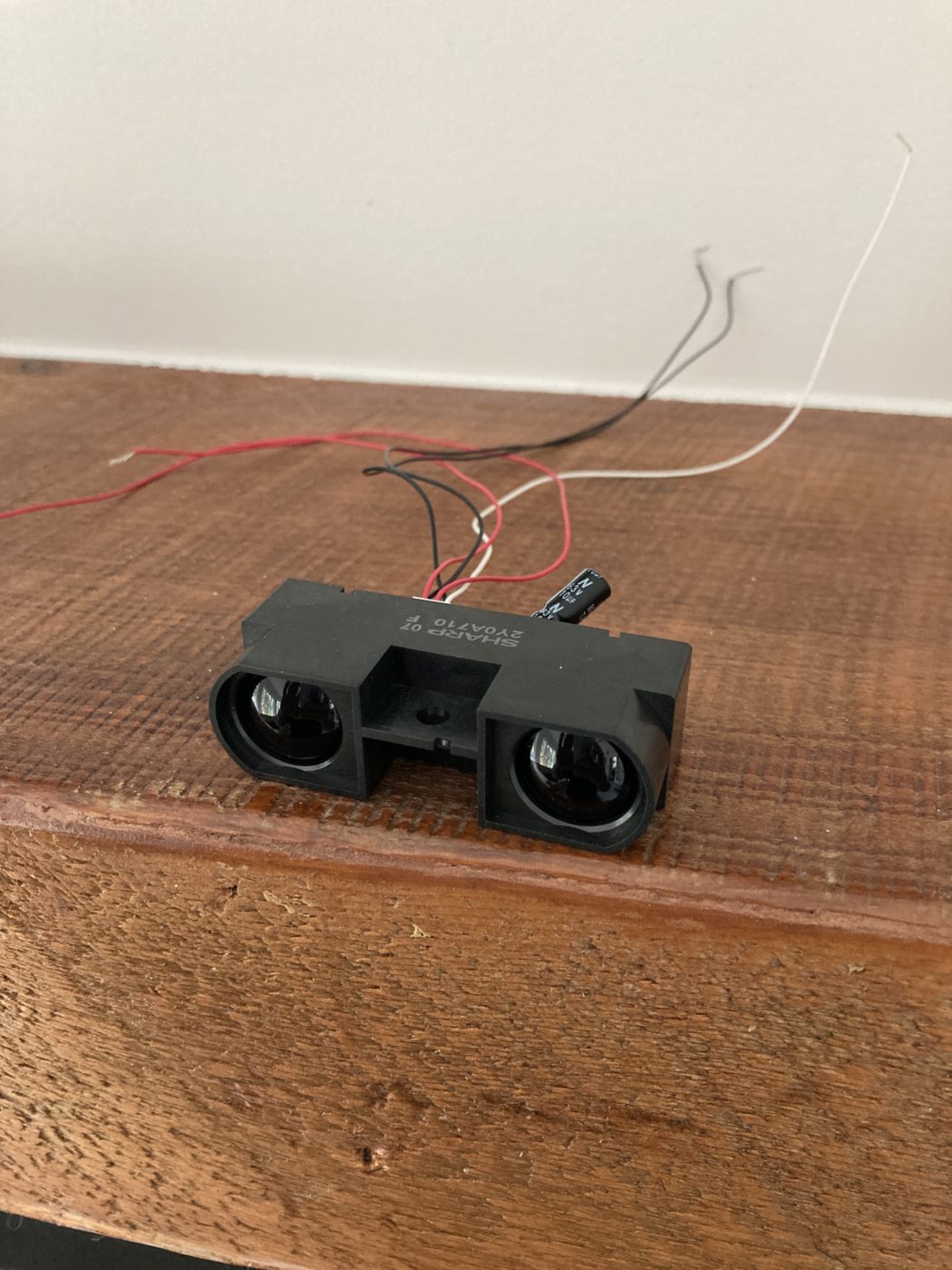
It is very non-linear though, with the response shown below.
We can see that the sensitivity of the sensor at the range we need, 300cm-400cm, is pretty low. Hard to detect the difference between 13′ (no one there) and 9′ (4′ target): 400cm to 275cm. It’s only a difference of about 200mV in output. On an 8-bit ADC at 5V reference, that’s only 10 bits which in our experience is well below the noise level of these sensors. I set this sensor up as a test and sure enough, it was not useable. I tried a moving window average of 30 points to 100 points to reduce noise, and it made it a bit better but detecting 10 bits in 255 is just too hard.
In this application we are not detecting distance but just presence, so I ordered a PIR (passive IR) sensor. These are detectors similar to the Sharp IR sensors, but they don’t use an emit-bounce-measureTOF model to detect range, they just measure ambient IR. But they have electronics built in to do filtering and detect change in IR, so they detect movement rather than presence, and don’t measure distance. You’re familiar with them from your motion sensitive lights by your garage, or your home alarm system in your hallway. They can be had for a few dollars, compared to $25 for the Sharp long distance sensor above. They also have built-in potentiometer tuning for sensitivity and on-time.
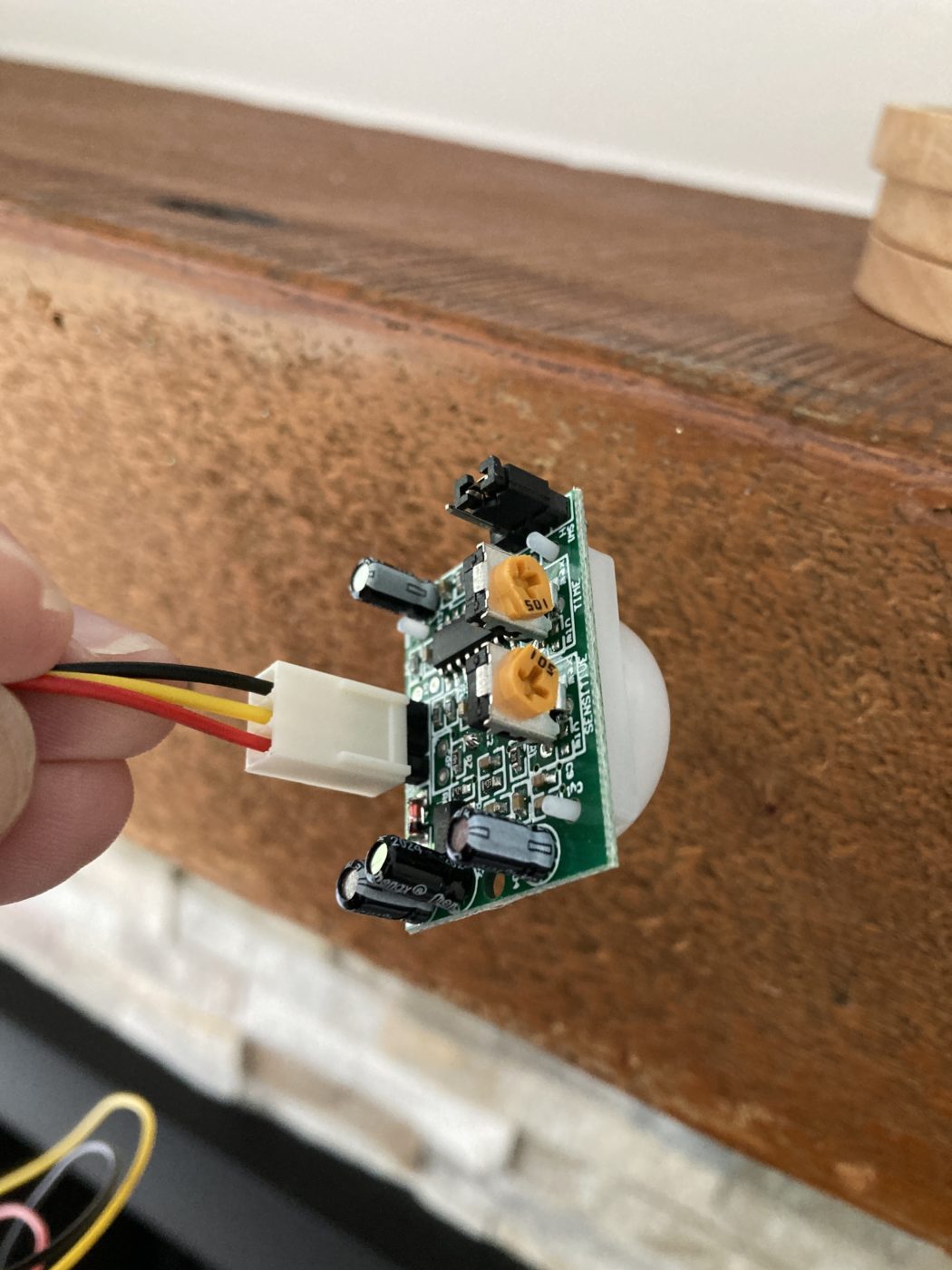
Interfacing this to the SAI was a breeze: the output line goes high (3V) for 2 seconds whenever something moves in front of it, and then goes low again when movement stops. That’s easy for us to detect using the SAI.
May 4, 2021
We covered the soldered ends in black heat shrink to continue the black, white, clear motif. I wonder if the wire strain is still a concern?
We created two clips, one to hold the LEDs and one to hold the wire for strain relief.
We also made clips that are attached to the chevrons by press fit. The LEDs are recessed slightly. Some are parallel to the chevron, others are perpendicular, and the other is 30 degrees. Now we need to decide if we like the look of the clips. And then try and figure out where we want the lights and at what angle?
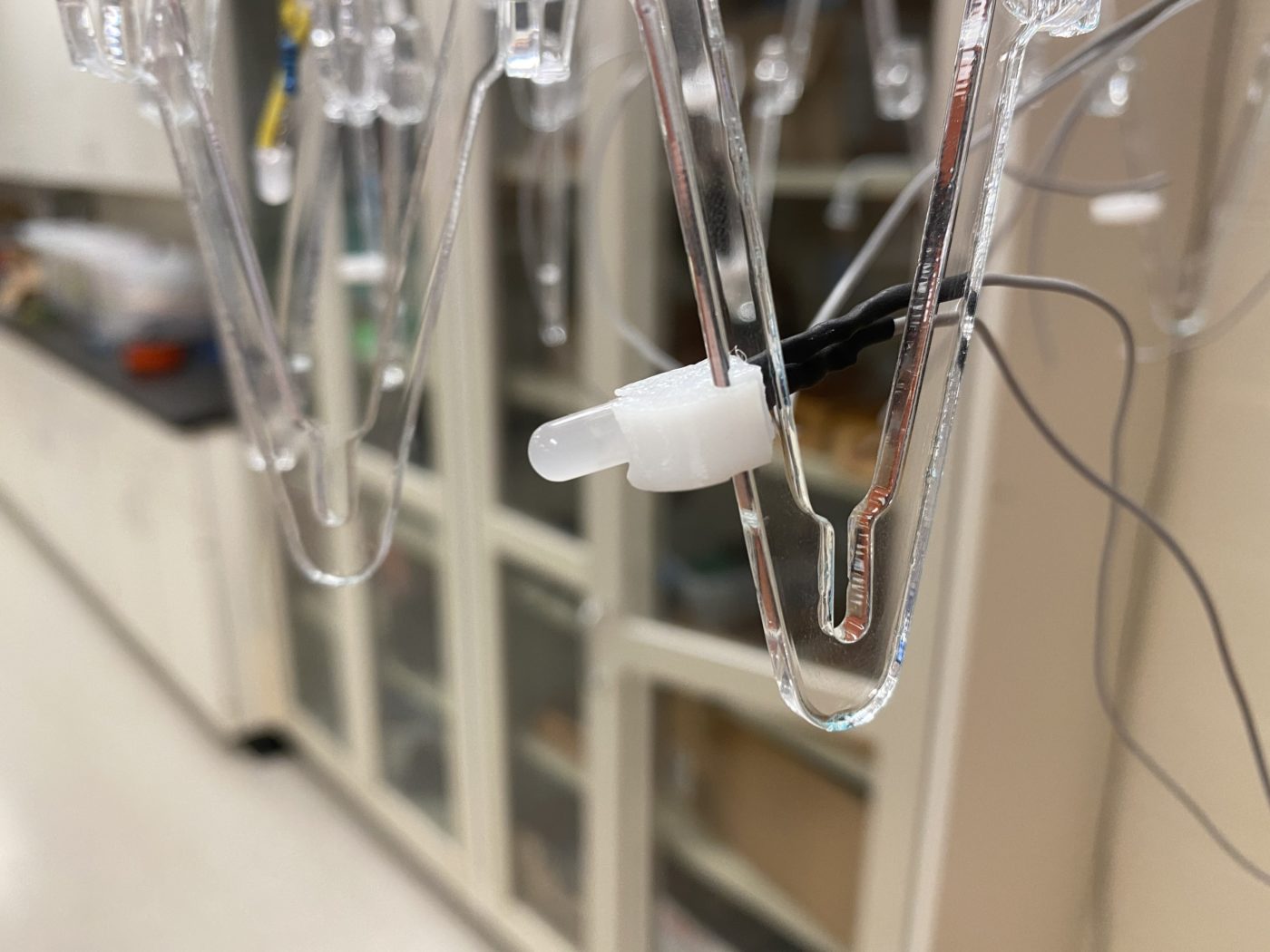
We also connected some LEDs to the SAIs using the new and improved (but not perfect yet) SAI cases. These ones reduce strain at the connector.
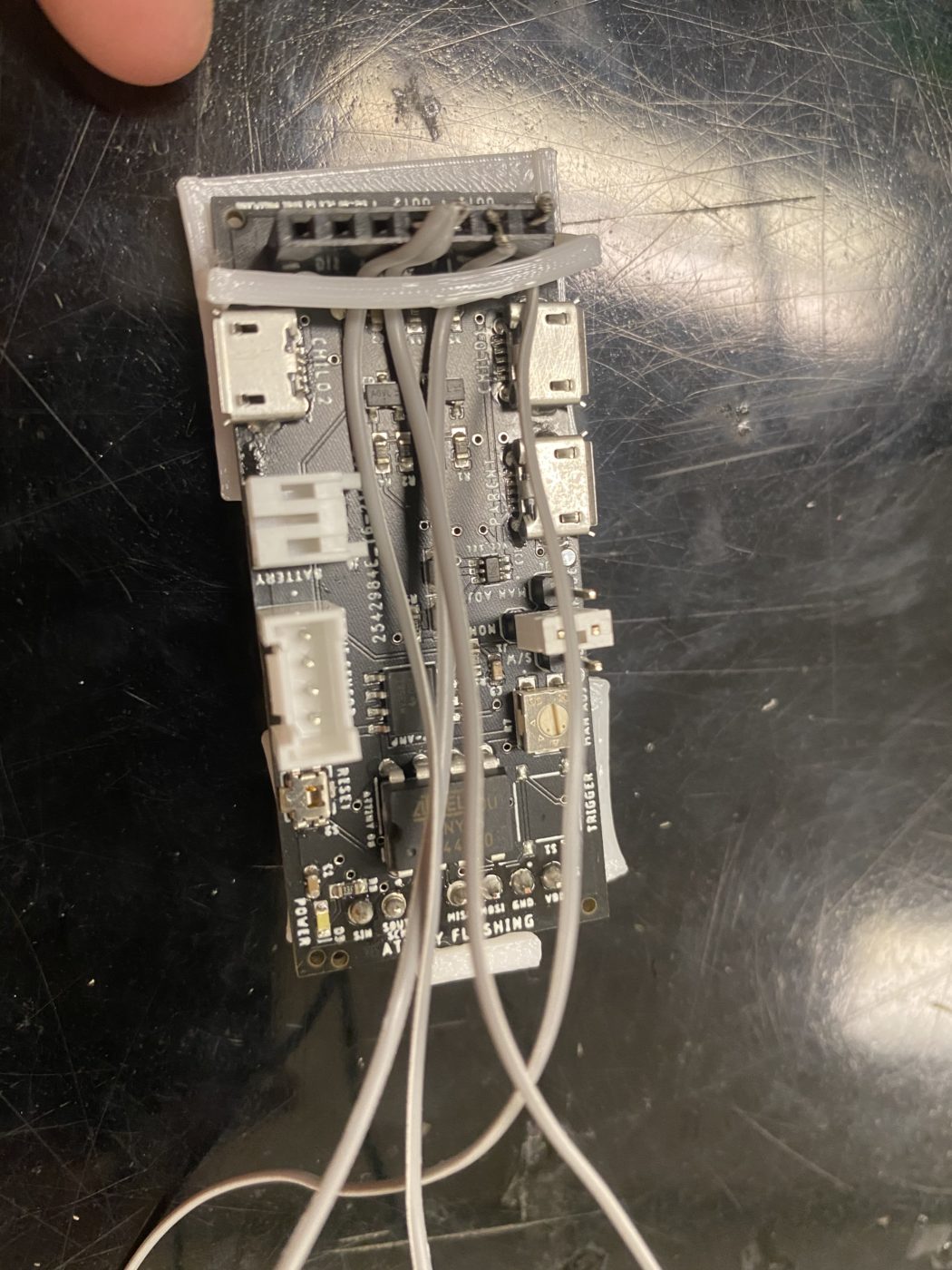
May 3, 2021
We are still trying to redesign the SAI clips to protect the back points from short circuiting on the metal spine.
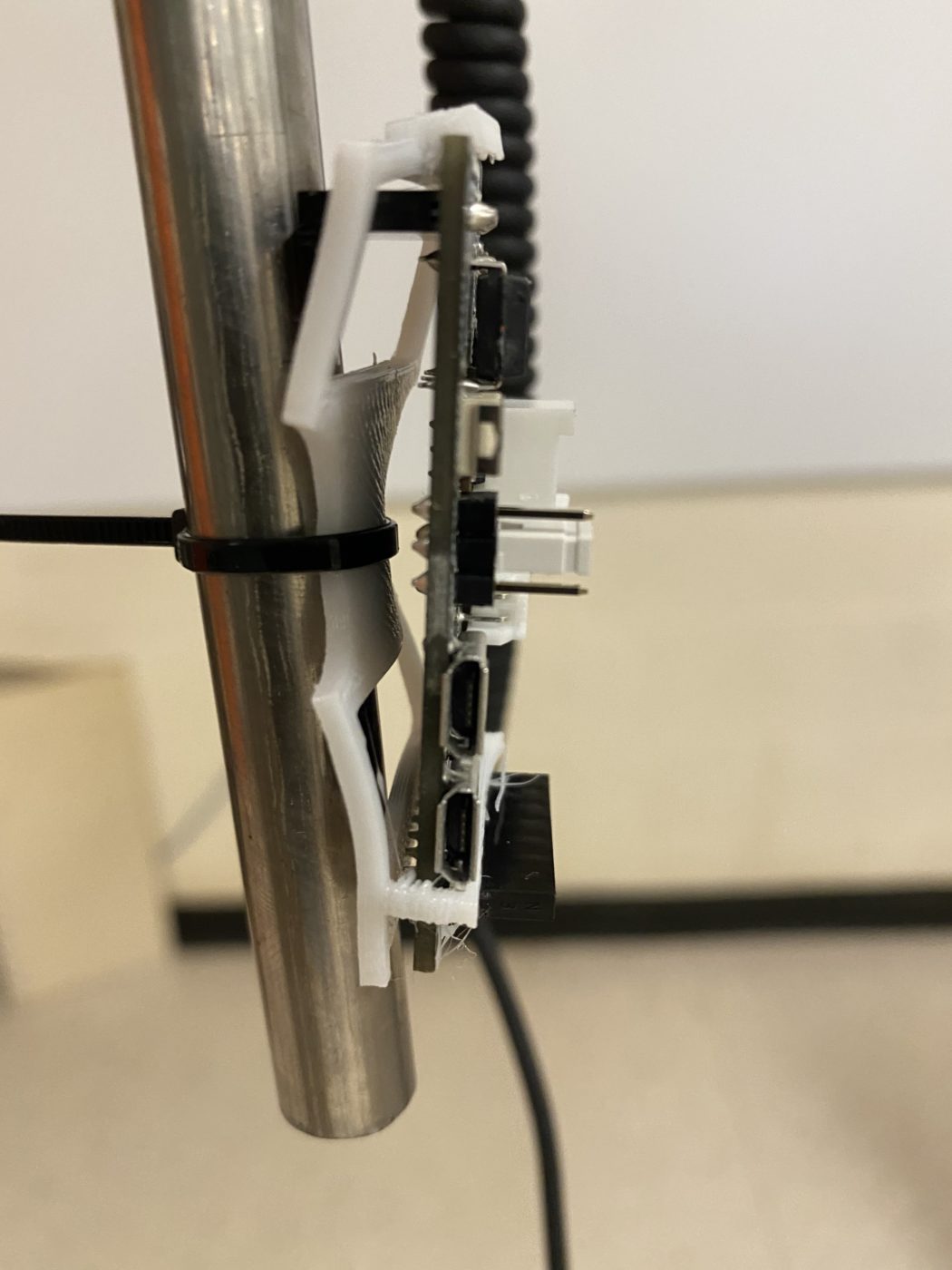
We are also trying to figure out how to clip the LEDs into the structure. We have diffuse lenses so they should go in many directions. Originally they would peek out past the edge to the column pointing downwards. But maybe we want them to point into the acrylic chevron and take advantage of that reflection, refraction and diffraction?
Keeping the LED tails apart is critical. We were planning to use heat shrink which is difficult if we also want to keep the ribbon cables together for strength. Maybe we use tape instead which gets hidden by the clip?
We also would like a clip that takes some strain off the fragile connections?
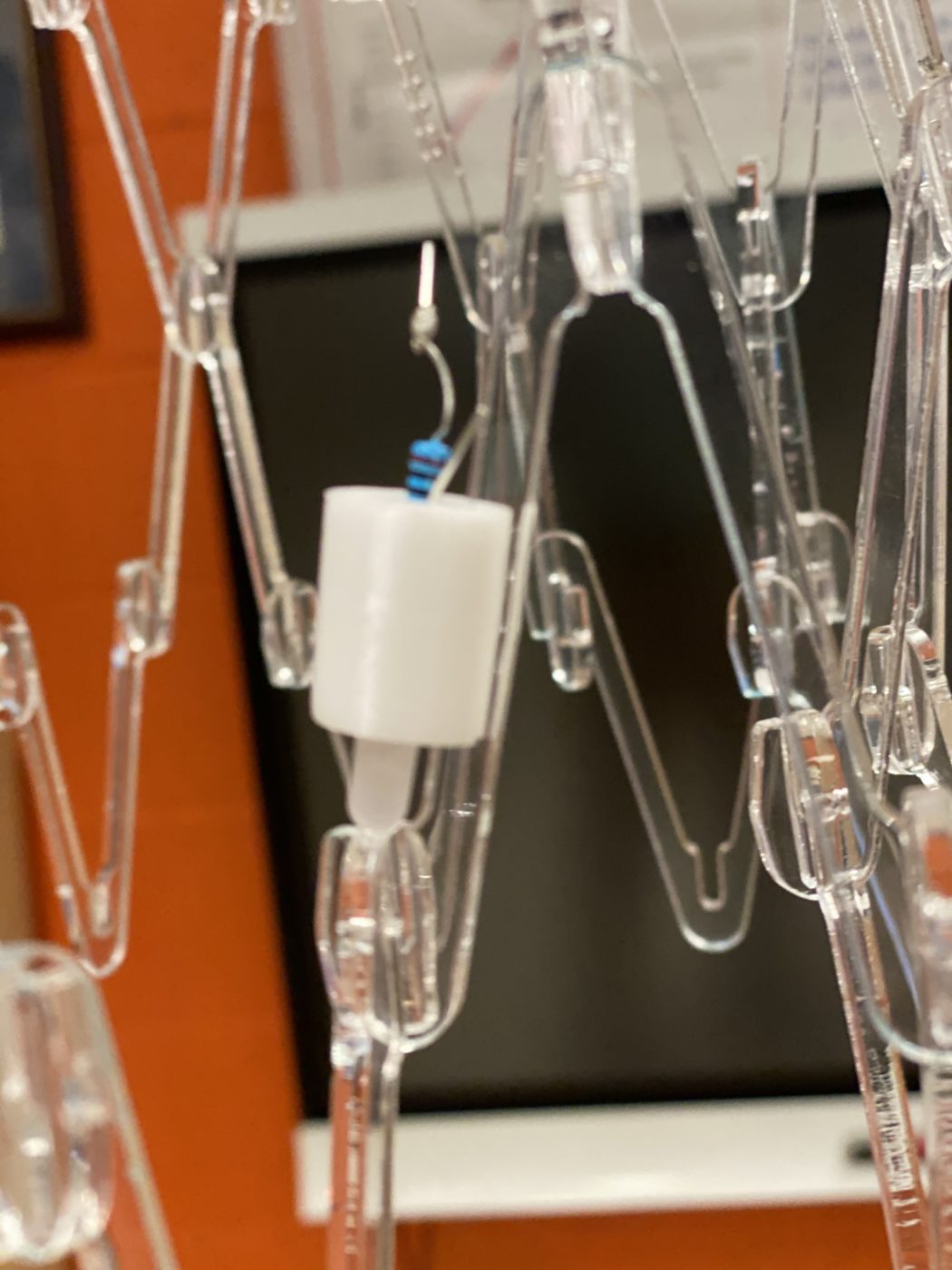
April 27, 2021
We used flexible rubber filament to build a minimal holder for the SAI. There is a gap so that the zip ties can slide between the holder and the board around the post. There is a small amount of tension on the rubber.
We are thinking about making a bit of an hour glass shape in the plastic to repeat the motif from the column and reduce plastic and maximize venting. The holder pictured in the last image has a little tab with a small lip that curls around and grabs the board.
April 19, 2021
Mia had trouble getting her light profile uploaded because she did not have the right driver. Today, she was able to finally see her profile in real life. She started drumming with the physical lights.
Myah who is hoping to be an architect, made some progress on her sketch up of the mall. She does not have a computer at home, so she is limited in the number hours she can spend.
April 9, 2021
Today has been a long time coming. Again a testament to perseverance. Rob asked me to test his manual and it worked pretty well. We had to worry about adding the Arduino ISP to the options but once we got that sorted out everything went just fine. We were able to use the Arduino to program the SAI. Then I walked onto the RHS SAI designer webpage and took one of the student designs, uploaded it to the SAI. It worked like a charm.
This has been a bunch of work by a bunch of people. Thank you LASG!

April 8, 2021
Perseverance. After many weeks of waiting for the spending freeze prior to the end of the fiscal year, we finally received some wide angle, diffused LEDs and some 100 ohm resistors. Some of our rookie solderers practiced putting the resistor in series. We used the process given to us by Rob. We first wrapped the resistor around the long leg of the LED, soldered both ends and then snipped the short circuited tail of the LED.
April 7, 2021
Our order that included the LEDs, resistors and the programmer has been delayed because of the fiscal year. We only have a few weeks to put the finishing touches on this project.
I reached out to my network to see if there was one around while we wait for our own. M responded. He is a previous student who would make things out of nothing like Inspector Gadget. He did not study for my physics test about free body diagrams because he entertained his younger brother by making an automated Jenga Gatling gun with Arduino. After that, he took apart a solar calculator and made an automatic blind opener that would open on the sun rise. He said he had a developer programming board to loan us.
Today l came to visit. Rob joined us as we struggled to follow the install manual. Rob’s manual is pretty awesome. We struggled to find a laptop with install permission. We found a Windows 7 machine that was super slow! We could not get the device to be recognized. After some significant time, we suspect the problem is M’s programming board.
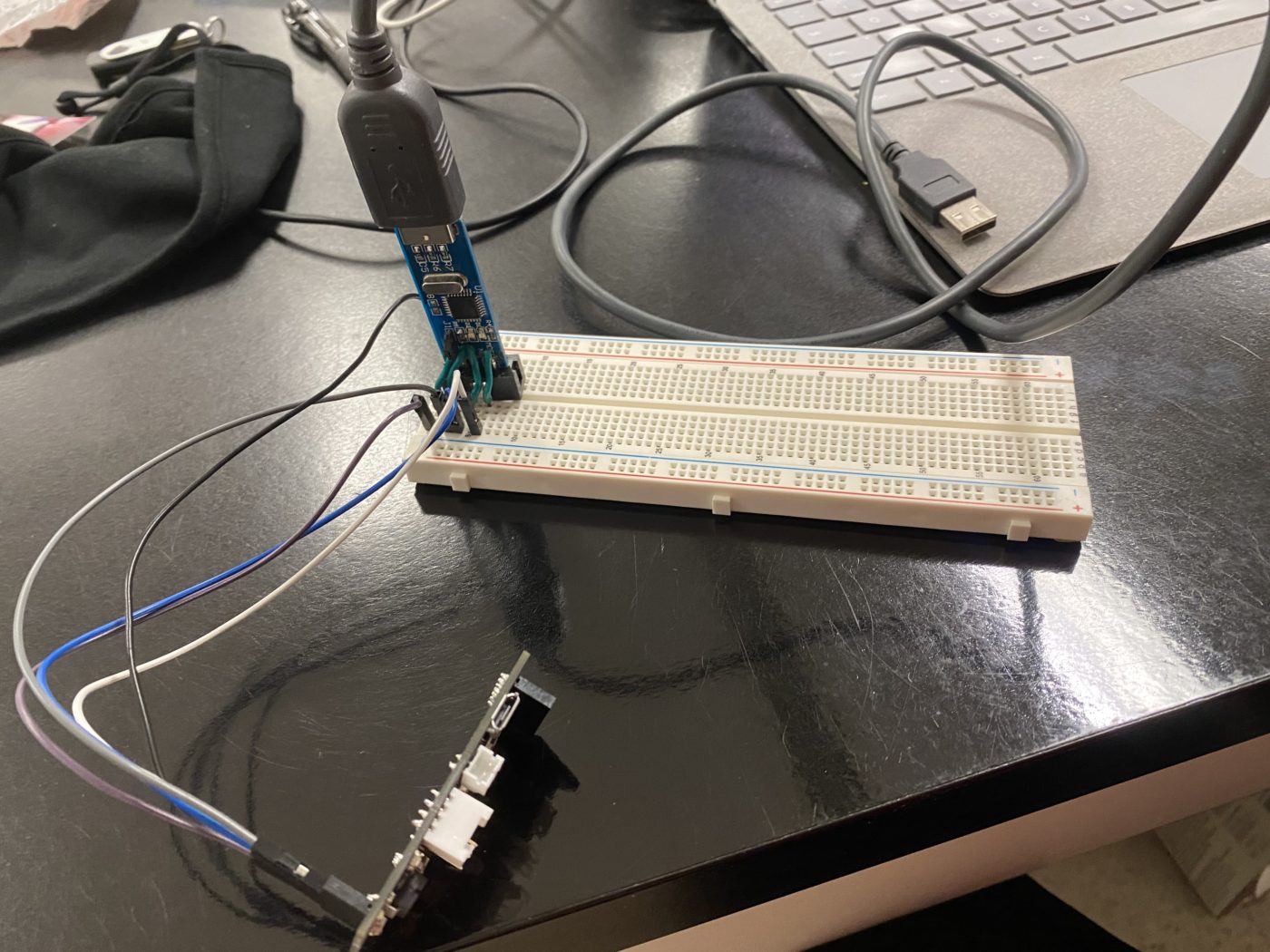
To rule out the computer as the problem, students running Windows 10 also tried it and had the same errors. Its USB does not seem to have a USB ID, which indicated the programmer might be the issue.M suggested using an Arduino as the programmer. Rob did some work and added this to the user guide.
I put a rush order on Amazon. New Programmers that Rob suggested should arrive in the next couple of days.
Mar 18, 2021
As smooth as Will Smith, we played with the SAIs, the 3D printed jig.
We 3D printed the jigs with the posts up in the air. The bases were a bit warped despite a warm bed. Next time we should print a mat.
Mia soldered one, but with the last header on the wrong side. Her soldering joints did not look like the nice Hershey’s Kisses like Rob’s. Rob is using lead solder and we are not, which makes it a little bit more challenging.
Mar 17, 2021
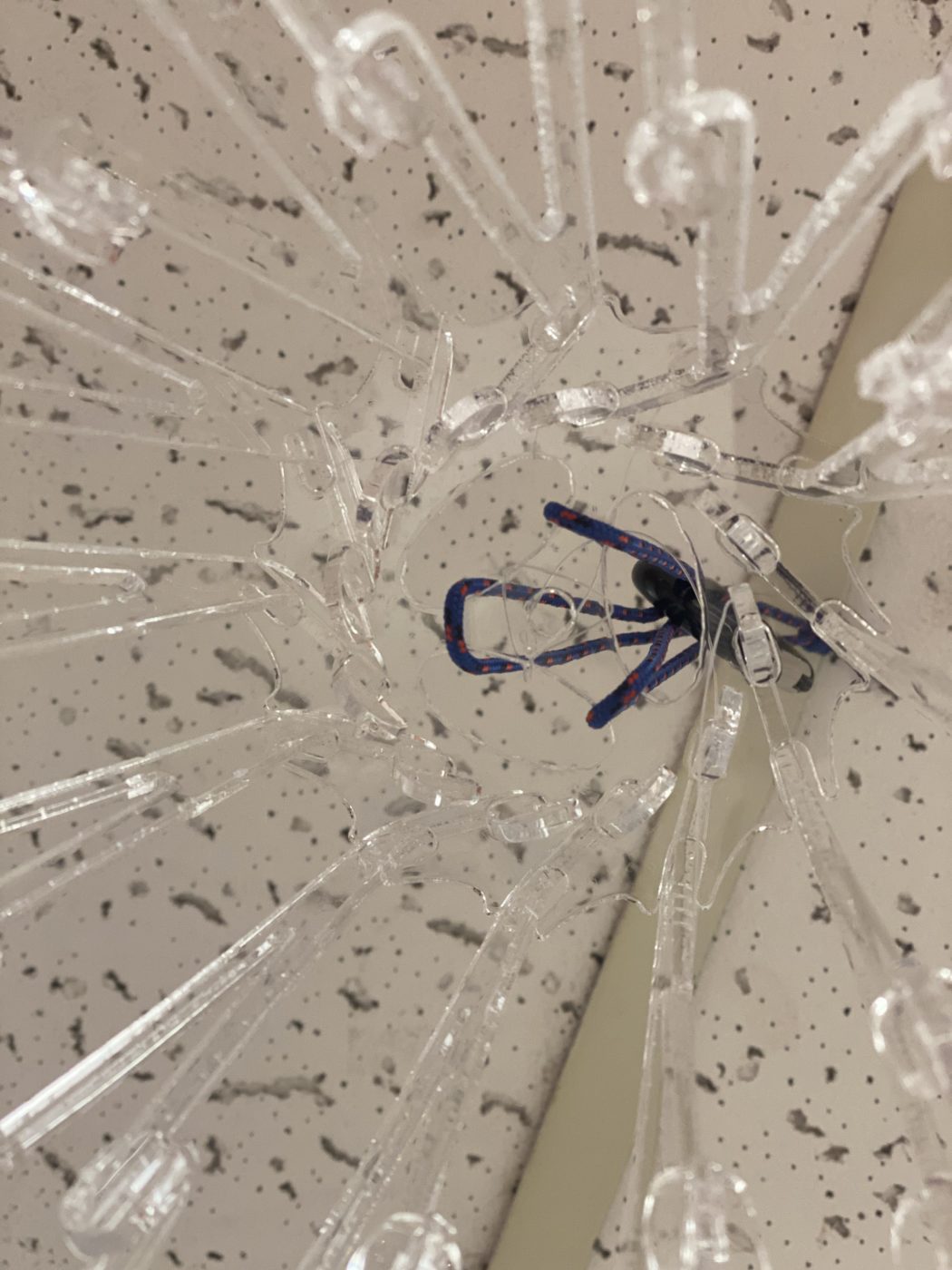
Maddi and Winter were F2F (face to face), and so they continued to build on Mia’s progress.
They were putting on the bottom plate, they pushed down a bit and the 20 lbs test fishing line broke!! The whole thing came down. We only had a couple of pieces break. Had this happened with the compression jaws, the pieces would probably have shattered.
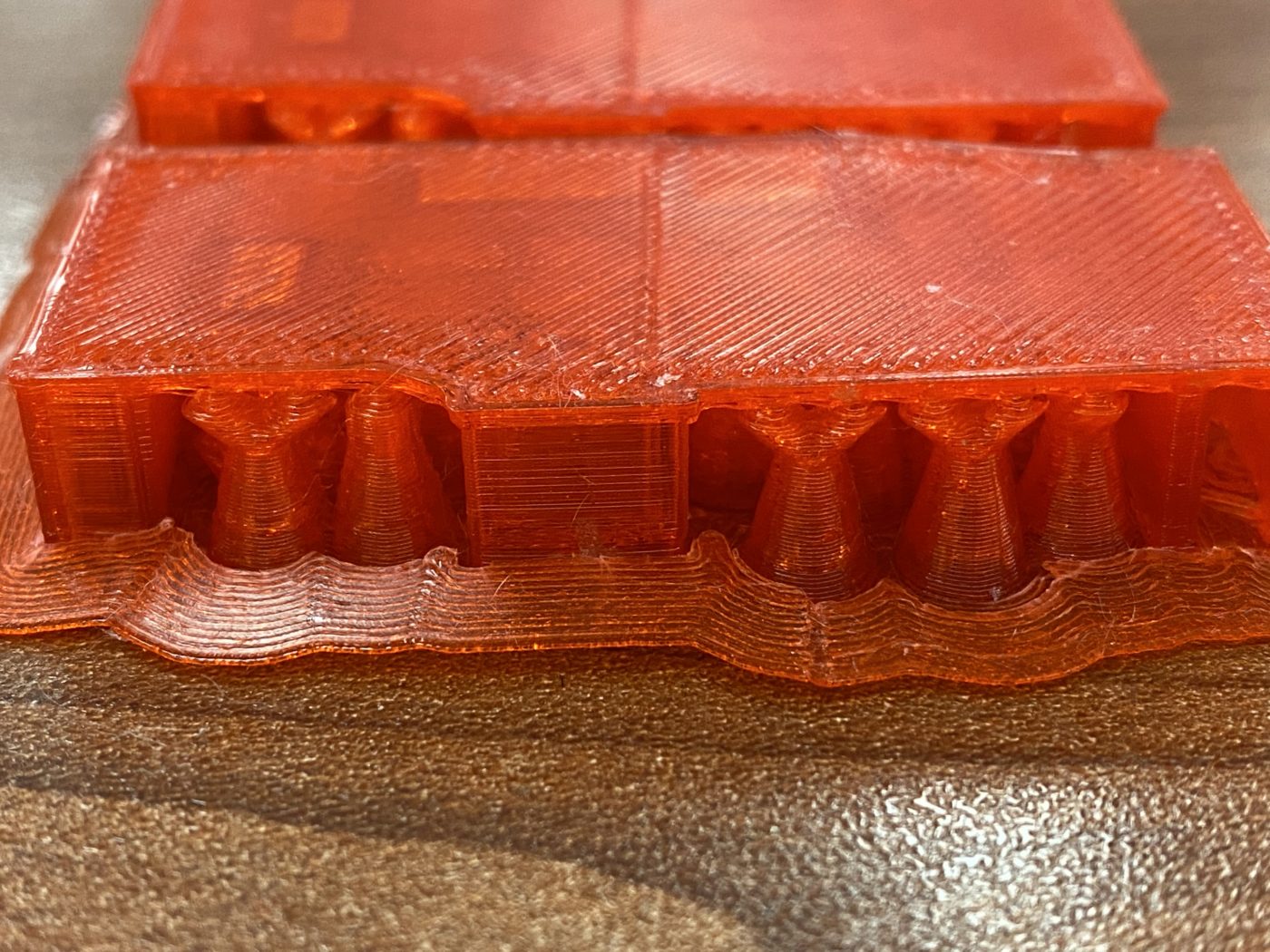
Rob had a good idea to come up with a name other than the column or the chandelier. Mia piped in right away and said “Emotion Enlightenment” working on the word play with physical enlightenment of the space but also the enlightenment of inner emotion, such as what happens during an anxiety attack.
They also looked at the hourglass idea of the new shape. There was some wondering about Greek, Roman and Egyptian mythology as well as questions about emotion and Freud. Words like Oyzys, Hedon, Kharites, ID, Ego, Pelios (I like the sound of Pelios, but wonder of its appropriateness).
Building on the god of Emotion, “In Hindu mythology it may be Moon, who controls the emotions and feelings with its waning and waxing or Kaam, who arouses desires in one’s heart or Saraswati, who is the Goddess of knowledge, wisdom and art, which can help in refinement of feelings and emotions.”
Mar 12, 2021
Too many chefs in the kitchen lead to some misplaced chevrons and a mis-shapen column.
It was fun peeling off masking. Check out Jordan’s face. Some students wanted to back up, remove layers and “make it correctly”, meaning “as defined in the blue print”. Others wondered about using this as an opportunity to rethink things. Perhaps we should leverage this beautiful mistake and do it deliberately for design.
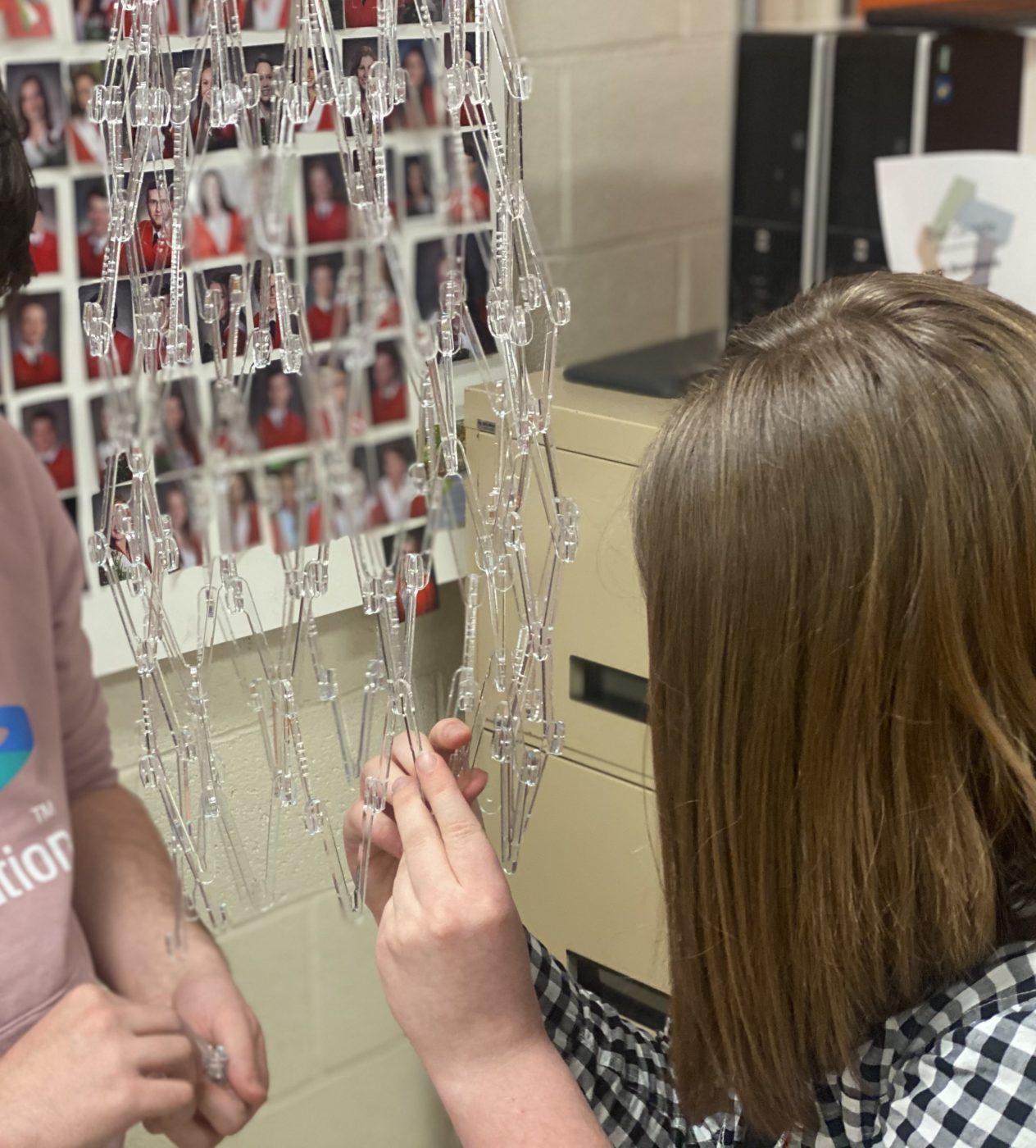
We decided to rebuild from scratch and use our mistaken discovery purposefully to create a new shape. Maddie made some sketches shown in the previous entries.
Mia decided to take an inventory of the pieces we had and design something new. She placed the layer plan on the white board. Then she was able to get the first 16 rows done.
Maddie and Winter came in over lunch to complete it. They had a hard time putting on the bottom plate without some of the jaws releasing, so Winter pushed down on it a bit and the 20 pound fishing line broke. OH NO! It was ALMOST caught on video. Time to redo it… again.
Mar 10, 2021
Over Spring break, Jordan ordered one of the PIs with a camera designed to read humans. He took a few minutes to talk to Rob about what he has done so far. There are two processes he is taking. One where there is a pre-learned library of recognitions, and another where it is smart but “unlearned” at the moment. Jordan is able to get a confidence level about thumbs up or thumbs down.
He is going to try some things like, how far/close do you have to be? How dark can it be? and then can you go from thumbs up and down to smiling/frowning?
This is cool and it could have some serious implications for our column, but also for LASG sculptures in the future. I wonder if Jordan will end up in Waterloo and wonder if this will have legs. Not to put too much pressure on a young kid, but I wonder if 5 years from now, Jordan will be involved at the studio doing something cool? This would be a nice proof of concept for tertiary schools and other organizations getting involved with public schools. This is a step towards having the outside community involved in an un-intrusive way to help personalize kids’ learning.
Feb 27, 2021
We need to begin thinking about assembling the SAIs. Since the SAI’s produce 5V and our LEDs are only 3.2 V, we will need to create current limiting protection resistors. There is a really cool way to make them by wrapping the resistor around one leg of the LED, soldering both ends of the resistor onto one leg of the LED, and then snipping the LED leg. But what is the size of the required Resistor? This is a good excuse to talk about Ohm’s and Kirchoff’s Laws with a voltage divider. The students have done Ohm’s law, but that was 2 years ago in grade 10 and we won’t be looking at it until May of Physics 12.
Rob went through the Voltage divider and how you might use it to send a signal to a microcontroller. There is a misunderstanding there. In the voltage divider, there are two resistors in series, and in our case a variable resistor for one of them. They wondered why the static resistor is necessary at all. Why can’t the variable resistor be sufficient on its own? I believe the answer is that, if there is a variable resistor on its own, the CURRENT will fluctuate but the voltage will not. The microcontroller measures VOLTAGE for a signal not current. So by adding the second static resistor, we can fluctuate the VOLTAGE which is microcontroller ready.
Feb 26, 2021
The vinegar battery did not do so well after 24 hours. There is inconsistent voltage between the cells so we wonder about things like a consistent length of wire, consistent exposure, consistent connection between the wire and the nails.
Feb 25, 2021
Ella revisited the vinegar battery from last semester. She had enough cells to get into the 8-12 V range without load to light an LED for 5 days.
We would have liked to have a battery that lasted much longer. I do not want to refill the chemicals every week. We wonder if we can drop the voltage and increase the volume to extend the lifetime. However, it still has to have enough ummppff to trigger the SAI. I do not know the minimum threshold for the SAI or a Zero Pi to register as “high” or “low”.
Rather than using the ice cube trays, she used 500 mL Florence flasks. Instead of the concentrated vinegar, she used regular vinegar and also diluted some vinegar. Visibly, we can see black flakes and hydrogen bubbles were abundant. We were able to measure some voltage around 300 mV and very low current, around 30 mA using 10% household vinegar. We wanted a larger surface area, so she used a 7 inch spike for the zinc electrode and lots of exposed stranded wire for the copper. We did not apply any load, just the ammeter and voltmeter.
We took readings every hour and let it go. It is still in progress. But after 1 day, the voltage has dropped significantly. I think we need to have some kind of load in there. A capacitor would be a good idea because that will eventually be the trigger in the future, but how large?? That would depend on the minimum threshold voltage for an SAI.
Feb 21, 2021
Today was exciting! We received 5 kits with PiZero and sensors!!!

Just in time to talk about pruning the options for a trigger. We talked about the idea that each LED had a constant colour, that we could have 20 SAI’s with 2 LEDs each. We can have a few different strings and the string lengths could be different. Does that mean one string is Angry and another string is Sad? There was also a discussion around using colour blown glass bulbs instead of colour LEDs. I was hoping to use those coloured bulbs for a vinegar battery that would trigger a strand.
Can one sensor trigger a string of lights and another sensor determine the pace. For instance, it will be triggered by proximity, but the pace would be determined by volume in the room?
What if the chandelier was attention seeking? Will it throw a temper tantrum if people ignore it? What if the chandelier shook a bit after it detected a random number of people walking by but not stopping to observe. Maybe it would shake on the 3 people who walk by, or maybe it is the 10th and then the 2nd? Could we use the buzzer to make a soft noise and a little bit of shake? This is around the 28 min mark.
How would we know if people are walking by it and ignoring it? as compared to walking by, stopping and then walking away? (min 35 to 38) We talked a bit about how we might use the ultrasonic sensor (or lidar) to know if people were standing and watching or if they were just walking by.
Feb 16, 2021
These are not all the ideas. Here is the recorded video.
Feb 6, 2021
We talked a bit about brainstorming and being creative followed by pruning. I talked about the idea of not having any bounds for a little while. We talked about the idea of DIFFUSE THINKING (which I picked up at the IEEE conference at Princeton with Rob and Lucinda). There is a reason that good ideas come to you when you are preoccupied with automatic tasks like sipping coffee, taking a shower or walking the dog…if you don’t contaminate it with playing a game on your phone or perhaps listening to music. You need to just BE with an idea for a while and it needs to percolate. Since we are not under a strict deadline at the moment, we had some time to ponder. So before we prune, spend this week pondering other trigger behaviors. Rob suggested that students produce simple sketches, maybe comic book style that describes the sequence of events for the trigger. A person walks along, they arrive here and then the light does a thing. I challenged them with some homework. We will see. I will make a collaborative space on our OneNote inside teams. Then I can send it to LASG later.
Jan 22, 2021
Today, Matt rearranged his schedule to be with us. So far, students have thought about what messages different lights give, graphed emotions and thought about how to convey those emotions in lights. They have worked on the SAI Profile to turn lights on and off and learned how one SAI can trigger another thinking about the difference between automated/mechanical and natural/alive. Just because individual lights might convey an emotion, we need to worry about how they interact with each other so that they behave as one organism, similar to individual shorebirds acting like a single living being, or at least appear to.
The primary structure of amino acids is just a string of amino acids. While the individual amino acids dictate the secondary folding into helices and sheets which then form into globular proteins, it is only when they form the caves of the tertiary structure that it has the active sites and the biological functionality.
In our lights, perhaps we are starting on the primary structure, but we also need to start considering how they will be arranged in physical space. The individual lights might turn on and off, but in physical space does one turn on at the top and then directly below so that it flows from top to bottom, or does it sprinkle like pixie dust or fireworks all throughout?
Calvin is fairly far along on his “excited” profile but needs some help. It quickly turns into a big mess. Matt helps him with the dampening, the cooling down period and how to trigger at only one sensor at a time. It is enough so that Calvin can continue on his way.
Matt figures out that perhaps there needs to be a way to turn sensors on or off at different SAIs. He made an interesting suggestion about triggering multiple loops. They have not really clued into the idea that you can have multiple profiles inside a map. I am also not sure that it has sunk in that two LEDs from the same SAI can be arranged and mixed up with the other strings. It does not have to be AA from one SAI and BB from another SAI. It could go ABAB or ABBA. This feels a bit like poetry rhyming schemes.
Today was a big step forward. It feels like we are on a roll. We have the building happening, we know something about the batteries now and we are making progress on the Maps.
Jose started to ask about how we are physically going to connect the lights and the electronics to the column. Matt challenged them to say that perhaps things do not need to be hidden, but they do need to be deliberate and thoughtful reasons to hide or not to hide.
Jan 20, 2021
Word of the day, “delicious”. Way back in Sept, I introduced the idea of a vinegar battery that would run for a long time, and would gradually build a charge on a capacitor that when fired would trigger a behavior.
The first step was to figure out if we can even make it work enough to light an LED. I did not mention more. Ella was the only one that did her literature research, designed the experiments, got the supplies and did the experiments. She did more than one experiment, she also designed her own next steps that helped to isolate variables and come up with some hypotheses. I appreciate that she pondered the results and designed the experiments on her own.
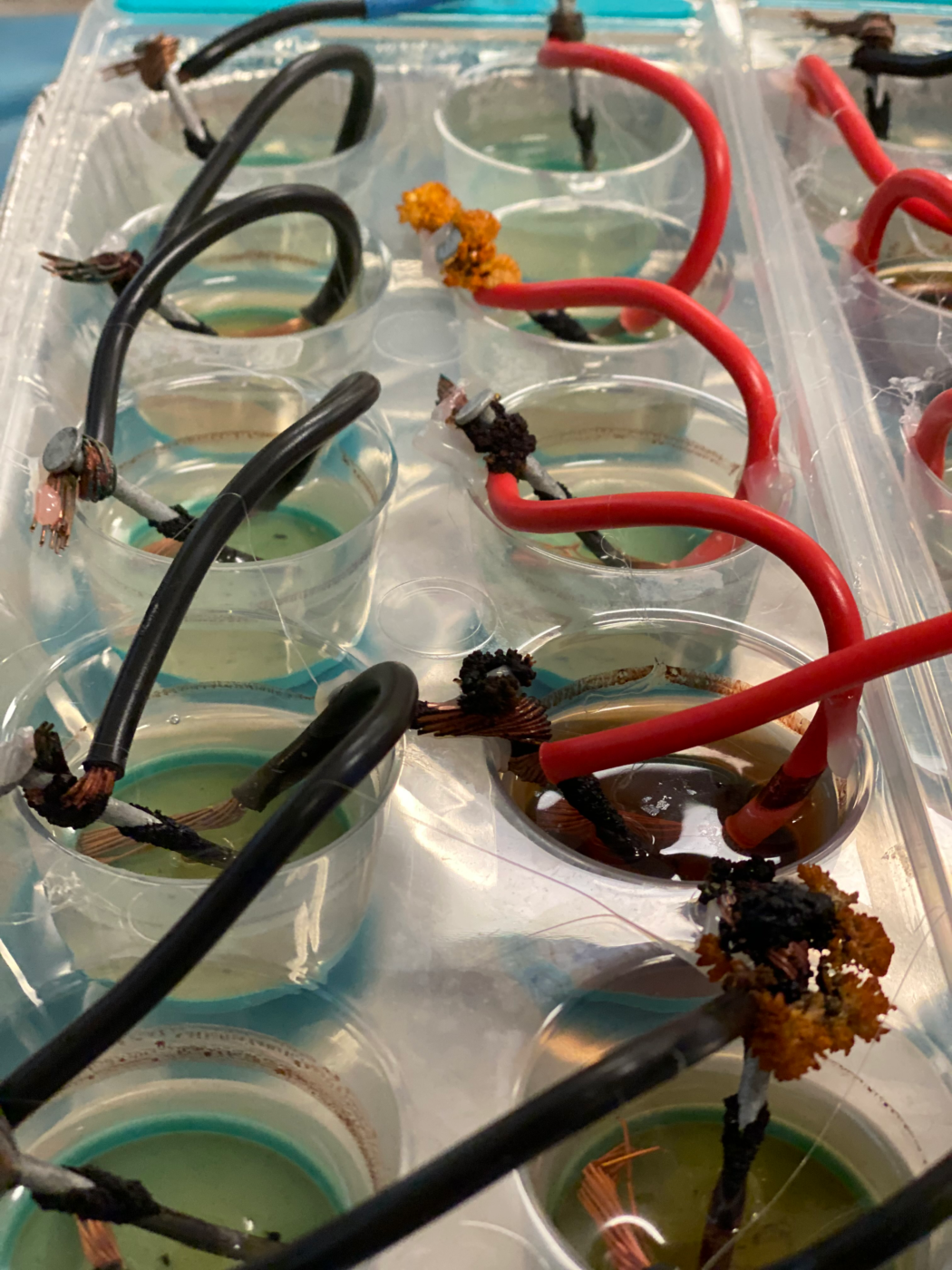
Today she presented to both Rob and Philip. Part of the rubric has 20% of the points reserved for a presentation to an outside audience.
We had great directions about how a PowerPoint poster would be different from a PowerPoint talk. She not only took my advice, but she also applied the ideas to other sides as well showing how quickly she moves from being an obedient robot to a thinker. I like that we all congratulated her genuinely for a great job, but also legitimately made suggestions for improvement.
Now the results. She found there the higher the concentration of acid, the higher the voltage and the lower the life span. She was able to get greater than 8V and last more than 5 days of a single LED light.
It makes me happy that it sounds like our ideal conditions might be dilute acid so that it trickles over time.
Since I’m not interested in climbing to the top of the ceiling every 5 days, I wonder if a large volume, dilute acid will suffice. As with everything, we will need to find a balance of sufficient voltage.
Next steps, I think I’ll show her some analytical skills and use pipets and probe ware to measure voltage and current. Can we make a graph and extrapolate the settings for the battery that will trigger a response intermittently for a year?
Wondering if we know the minimum size (current and voltage) of zap that the capacitor needs to be read by a Pi Zero and trigger a response? How big of a capacitor do we need? How slow can we charge it?
Jan 14, 2021
Victory!!
I have been searching for the correct settings for cutting the acrylic. Too low power or fast and it is not a complete cut and the edges do not melt. The edges are rough and not clear. Removing the pieces requires some force and it causes fractures, often just removing the pieces breaks them.
However too much power and too slow causes overheating and too much reflow and “refreezing”. Again the edges are very UN-uniform , white like snow cones and brittle. There was audible popping and cracking during the cutting like ice cube’s from the freezer being placed in warm water.
Finally with the help of Philip, we find what we hope is the optimum setting that gives a complete cut and enough melting to seal the edges to a mirror finish. They should be translucent all the way around. Got our set up, that means 99% at 0.8-1.1 inches/sec, around 2-3 mm/sec. It is so mirrored and translucent that Rob’s markings for jaw width were visible from the edges.
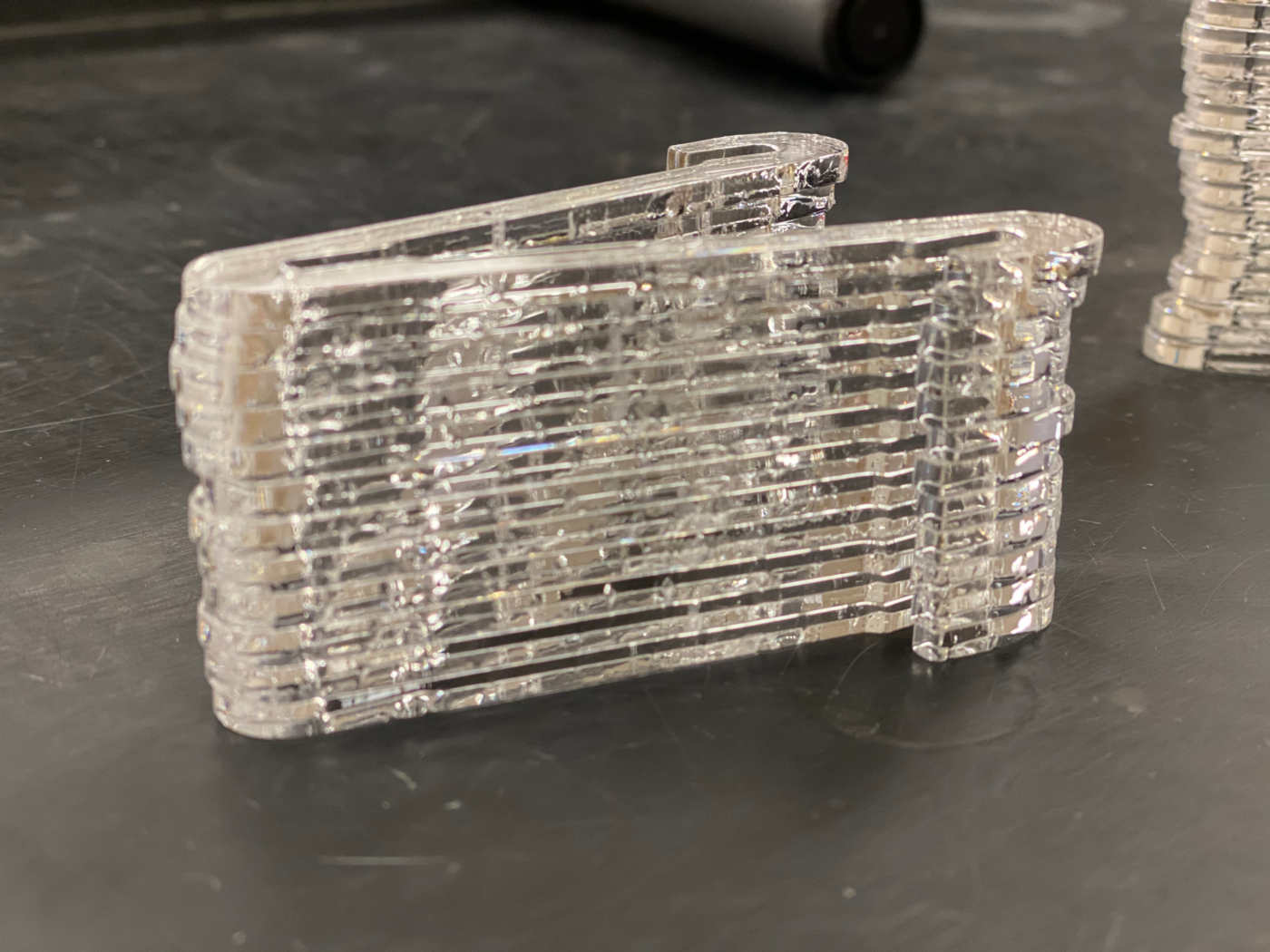
Nov 27, 2020

Now that we have an idea what the lights could do, we think we are ready to start being deliberate about the emotions we want to extract. Matt suggested that students act out, silent film style or Pictionary style, different emotions and perhaps record it ala Tik Tok.
One group was struggling with the superficial or the improv style, so I played a bit of word association, I say black, they said white etc,.. just to try and get the spontaneity going. We adapted it to acting the emotion rather than drawing.
Rob took one group and tried to graph the physicality with the emotion such as flash rate. Where would anger and sadness be on a graph that maps blink rate? There are a couple of good facial expressions on Rob’s face as he demonstrates.
Nov 25, 2020
We finally finished the hook tension column. This one took a couple of weeks only because of interrupted time on task. The comment was, “these pieces are a dream! They stay together so much better than the compression press-fit pieces.” I accidentally bumped into it and dropped it a bit, destabilizing it by compression and it only had a couple minor repairs.
Nov 20, 2020
Today was parent teacher interviews and so the students all had the day off. Almost all of them said that they would like to attend anyway, so Matt and Rob prepared another day of work, this time a second round with the GUI Interface so that students could program the lights without using lines of CODE. Rob assures me that we are helping Living Architecture by helping to beta test the SAI hardware and firmware. That’s reassuring. We hope it will become a model for future STEAM collaborations around living architecture.
Matt ran the show today. We reviewed the interface quickly so that we could control two LEDs (or other) with brightness and timing, with smooth or with “quantized” step patterns. There was some mention of some calculus and integration. I had flashbacks of Thompson’s and Simpsons approximations. FUN!!! Something to think about for future connections to curriculum.
Matt also unveiled a new part of the interface that allowed a light sequence to trigger another string of lights with the added ability to dampen (decrease the intensity) by a percentage. One of the demos showed how you could place a handful of lights in a circle, use the trigger of one to “pass the hot potato” to the next pair of lights and then using the dampening effect, it could gradually die out.
Now that students have a bit of experience, perhaps the next time this GUI is presented, I wonder if it should start with the effect first and then the tools. Start with what the person wants and then show the tool, or slider or reasoning.
This interface is very cool and I think it is a big step forward.
Nov 13, 2020
Today was our weekly conference. We have been struggling to get students to chat. They are not used to brainstorming or blurting. When they speak they want to give the “right answer“. This process does not yet have a right answer and so that is unnerving to them.
I created a survey of Starry Night, the Scream and the Thinker and Chihuly to get a variety of emotions. The last part of our meeting was to talk about what we want our work to evoke. This opened up to brainstorming and blurting. Before we started, I mentioned the idea of needing extroverts to get the ball rolling and then there being an awkward silence and then the introverts chime in, embracing the silence.
They came up with these ideas for the work. Calming, thoughtful, not angry or upset, energizing, curious, approachable. They did not want people to just walk by it. They wanted to have people feel that they are creative, interactive, and inspiring. I talked a little bit about going shopping in the mall in Canada and how I just strolled by things, ignoring most. But in the markets in China or Mexico, the vendors come out into the mall to get you. Can the art come out and get you? Then they got silent.
I mentioned the idea that people sometimes misinterpret the silence after a brainstorming session as a sign that they are done. I challenged them that perhaps it is just the superficial low hanging fruit that is complete and there is another idea just waiting to surface if we will again embrace the silence. Maybe the very first idea was the best, but I would want to have options. Having many ideas and settling on one gives more credibility than only having one.
Oct 31, 2020
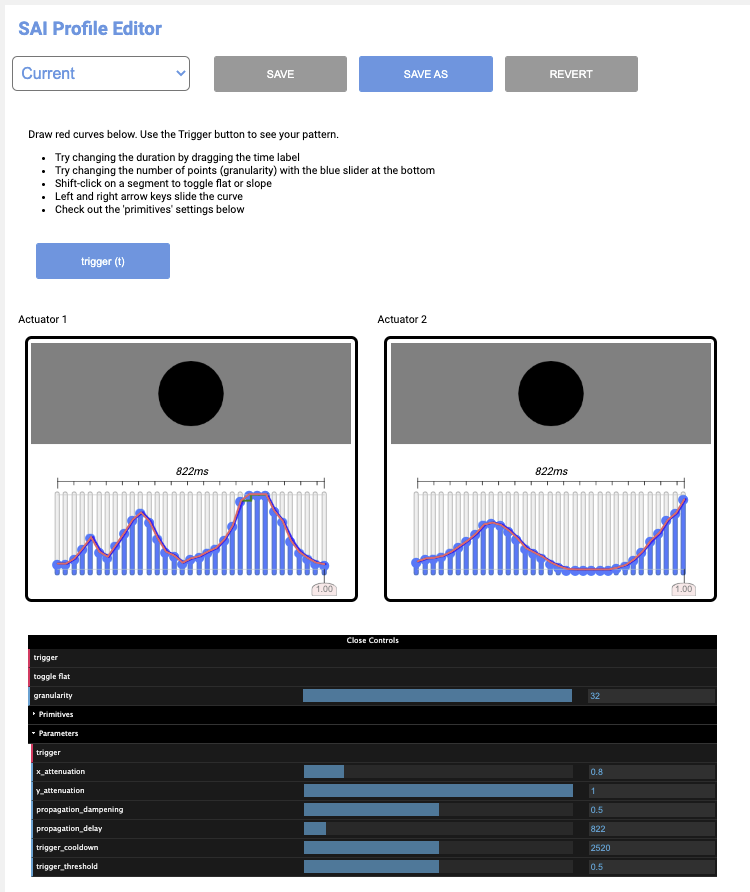
Today was Pivotal!
Today, Rob and brother Matt gave a talk to our kids about how humans can give life (agency/personification/autonomous) to inanimate objects like LED. They showed a cool video about triangles and circles and how we assign stories to make sense of the things that we see.
He showed that some lights tell stories, like a solid green light communicates that all is well, while a pulsing white light might convey that a computer is sleeping, but a flashing red light on a water heater with a sign that says possible explosion conveys something else.
If we want the chandelier to appear alive and not robot controlled, perhaps we should look to nature to see patterns that feel natural as opposed to contrived. He showed a video from National Geographic about fireflies in Mexico.
Then Matt showed us the SAI interface to control the LEDs. We are the first people to see this interface. Students were able to start creating profiles of different lights. Can you make a profile that evokes happy, sad, mad… etc…
Oct 28, 2020
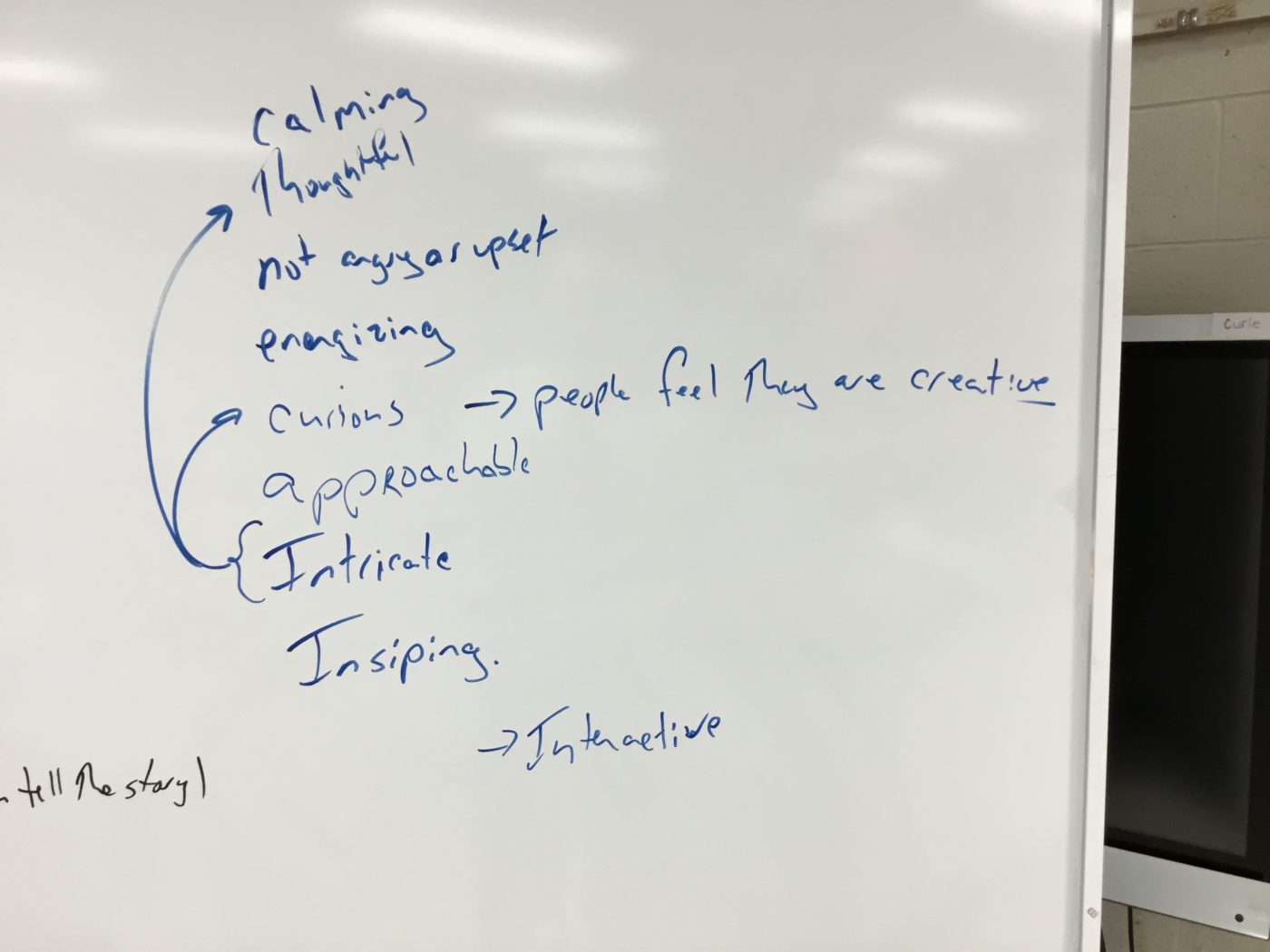
The chevrons start at 2D, but then when pieced together form a wavy corrugation kind of shape. Engineers use that same undulating shape in metal (for roofs and in cars) and in paper (cardboard) to provide light weight strength.
I wonder if Mother Nature has used some of these ideas to provide strength. For example, cellulose is used to provide strength in plant walls and is so strong that it is largely indigestible to the human digestive system and a major reason why cows chew their cuds and explains a good portion of their belching and flatulence.
Oct 26, 2020

The first press fit compression column had a hard time fitting together. The jaw size matched the uncompressed cardboard nicely. However, when the parts are manipulated the cardboard is too fragile and it crushes. So when there is any amount of weight or stress, it falls apart.
We crushed the cardboard, and used calipers to measure the average thickness of the cardboard to be 1.2 mm thick.
So Rob “opened his big mouth” of the cardboard jaws. It seems that the mouth of the jaw is wider to make it easier to fit the pieces together, but the smaller distance at the back/end of the mouth would make for a more snug fit.
One kid assembled the whole thing during class time while taking notes on naming binary and ternary acids as well as solving inequality algebra, in the morning. She made the sheet horizontally on the table, added the narrow chevrons, rolled it. She purposefully left the column of chevrons out. After they were all in the end caps, she then stitched the ends of the sheet to complete the cylinder. It is much more sturdy!!! It was faster because we knew what we were doing but mostly because there was minimal distraction in repairing.
We used a glass rod down the center. The friction in the cardboard seems to be fine.
This column seems a bit elliptical rather than circular around the diameter.
Oct 16, 2020

We talked about the idea that while there were some distinct areas of expertise from the building to the coding to the electrical to the vinegar battery, a major part of the project is to have all students experience all bits in enough depth to gain an appreciation of how they fit together and to perhaps even change one’s perception of themselves. Can they use an area of strength to explore an unknown area?
Oct 14, 2020
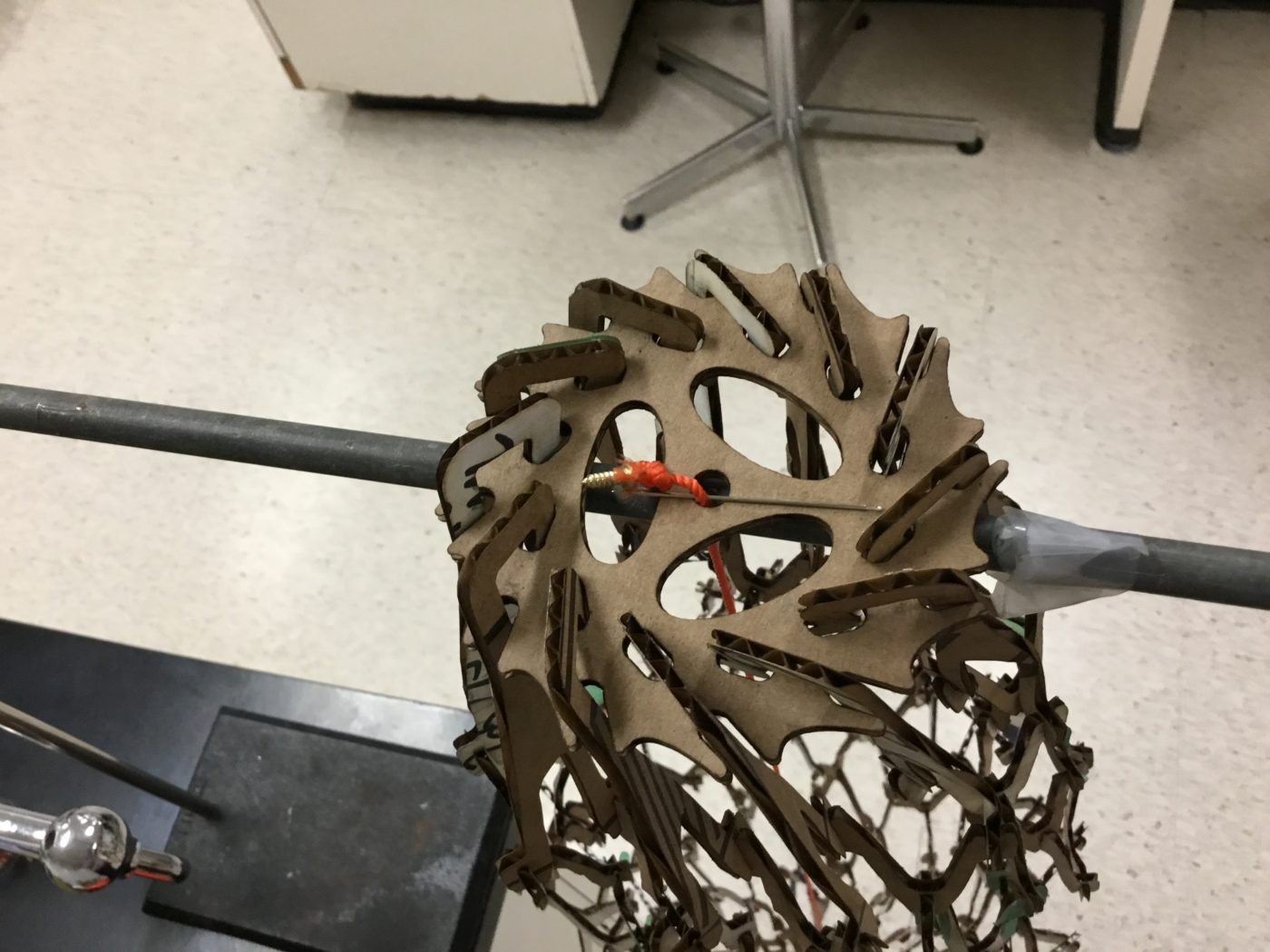
Today we tried it. As an educational piece, we used bright orange string down the center with a needle at the top which allowed us to easily adjust the tension. It helped A BUNCH!
Oct 9, 2020

Today we finished the first Cardboard Column. It is together, but it is fragile. There are a couple of links that are not connected and as we try to repair it, two or three others break apart. The cardboard is twisting a bit, but all in all seems like a pretty good model.
This time, she created the bottom half by making a long sheet of regular chevrons, connecting the narrow chevrons, then attaching the end chevrons and finally rolling it like a cinnamon bun to connect the end chevrons to the bottom plate. There was a little cheer when the bottom half was connected to the top half.
I wonder if it will be better to put a post up the middle and build from bottom up and use gravity to push the pieces together rather than hanging it and having gravity pull the pieces apart.
October 6, 2020
We have been struggling with our “3mm” corrugated cardboard to fit in the jaws. Rob and Nicola have been adjusting the files and I have been trying to scale them.
I stumbled upon a pile of trifolds for the typical science fair, they are a little under 3 mm. Perhaps I could try those with the original cut files…
Reduce, Reuse, Recycle, Upcycle.
It Worked!!…so far. The pieces fit so nicely together. Now we will see if there is enough friction to hold the weight.
One student asked, why do the jaws grasp each other from the bottom? Why don’t doesn’t the lower layer land ON TOP of the upper layer??
The student did not know it, but was suggesting the tension chevrons, which we eventually used.
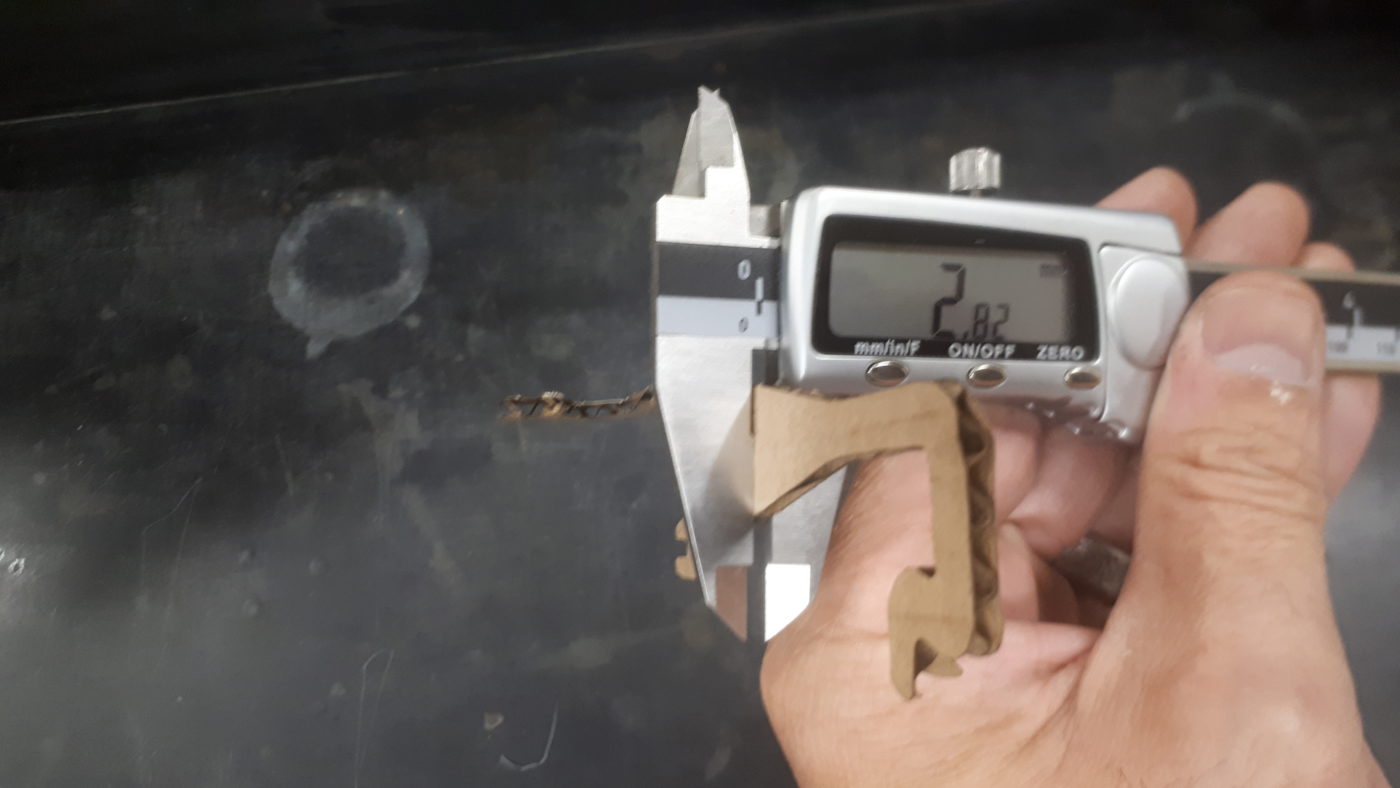
October 1, 2020
On a visit to the studio in Toronto there was mention of a vinegar battery that could periodically trigger an event. Quickly, zinc and copper are added to two vials of a vinegar solution with an LED in between. Could we connect it to a capacitor that would charge over time and then be used to trigger a behavior.
Inside the column design, there are bulbs which could hold the batteries. This could be a cool way to bring in Chemistry.
We could purchase bulbs, but we also want to bring in the community and another type of art.
The kitchen chemistry feel of the vinegar battery could be an interesting chem project for students to do at home during the COVID restrictions. It also speaks well for risk management. If the bulbs ever fell, we would not have some terrible chemical splashing everywhere. We will need to be careful if we get more concentrated vinegar.
We do not know if it will work, or how long the volumes and concentrations will last. Will it last for a day, a month or a year? They have some concentration experiments to do.
Also, instead of just having copper and zinc plates in beakers, what if we used copper wire and put some curls and swirls in it to make a design? I am not sure if I can get zinc wire or not. It could be interesting to build double helixes with the zinc and the copper wires.
RHS
Ian Fogarty, teacher
Meghan Best, teacher
Joel Fogarty, consultant
LASG
Rob Gorbet
Philip Beesley
Matt Gorbet
